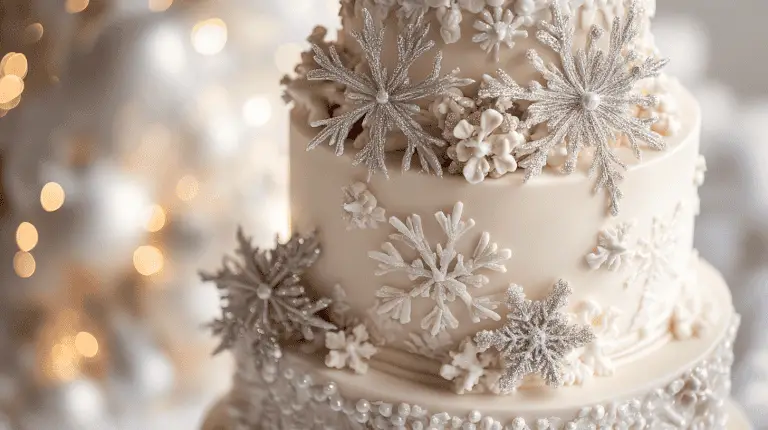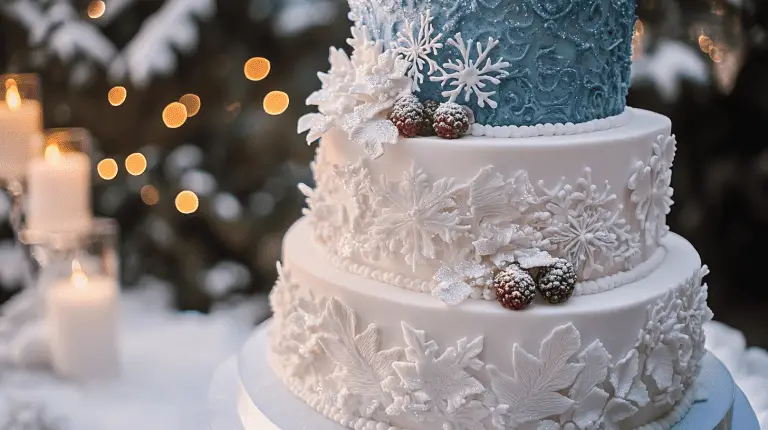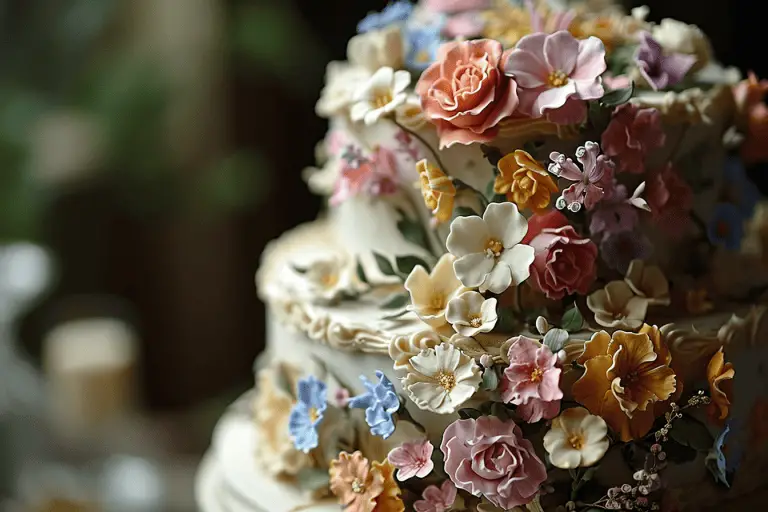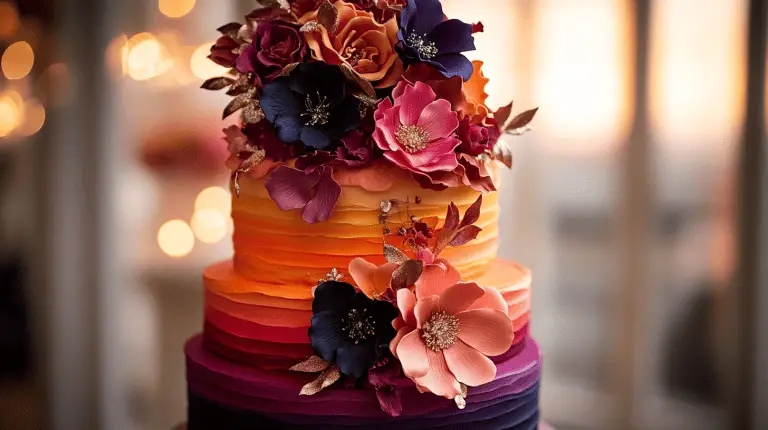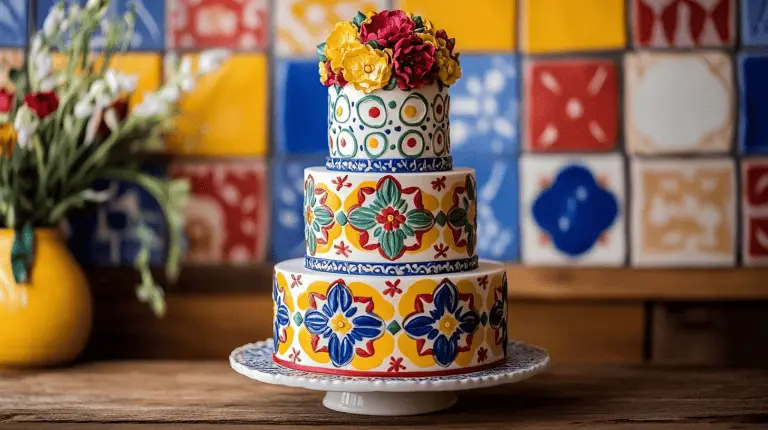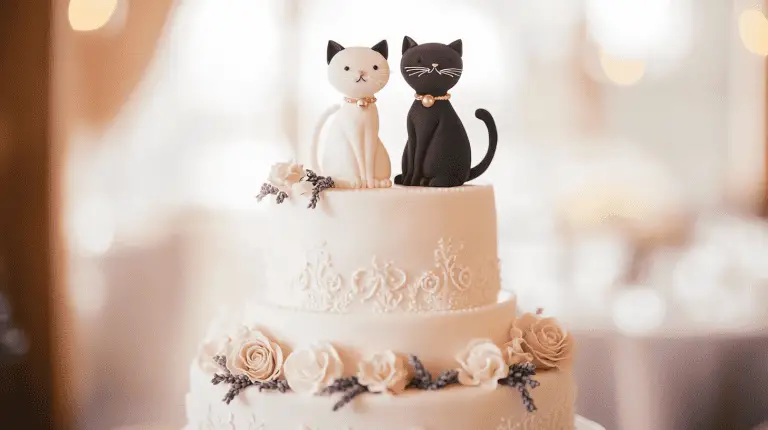55 Opalite Wedding Cakes: Ethereal Designs That Glow
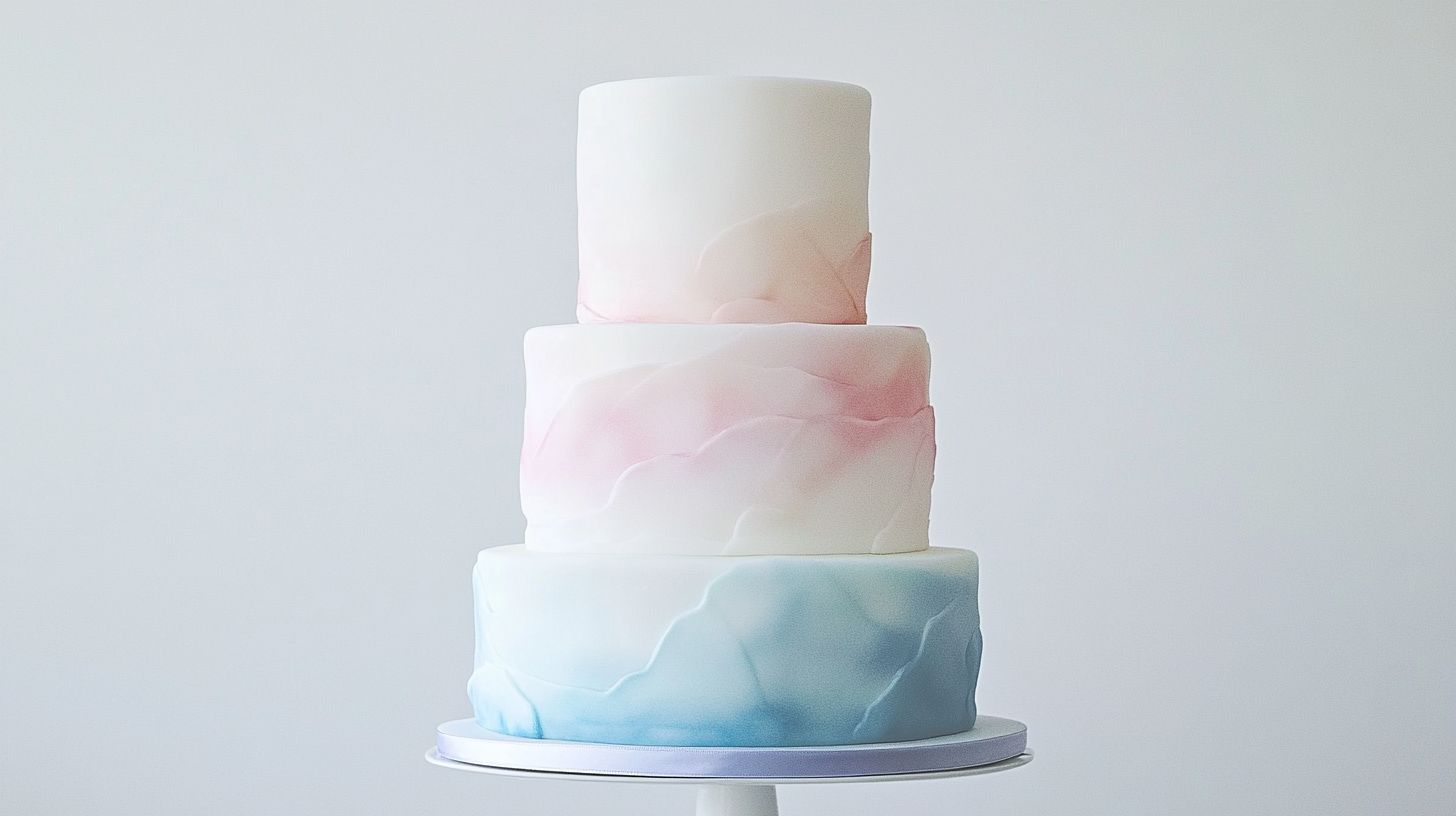
Opalite wedding cakes capture the ethereal beauty of this translucent gemstone, transforming traditional wedding desserts into luminous masterpieces. These designs incorporate the stone’s signature milky white appearance with hints of blue and pink iridescence, creating cakes that seem to glow from within.
Modern couples seeking unique wedding cake designs increasingly choose opalite-inspired creations for their otherworldly elegance and versatility across different wedding themes. The gemstone’s dreamy qualities translate beautifully into various cake decorating techniques, from watercolour ombre effects to intricate crystal formations.
Wedding cake designers achieve opalite effects through techniques ranging from subtle marbled accents to dramatic geode structures with edible crystals. These designs work equally well for celestial-themed celebrations, coastal weddings, or contemporary receptions where couples want something distinctly different from traditional floral decorations.
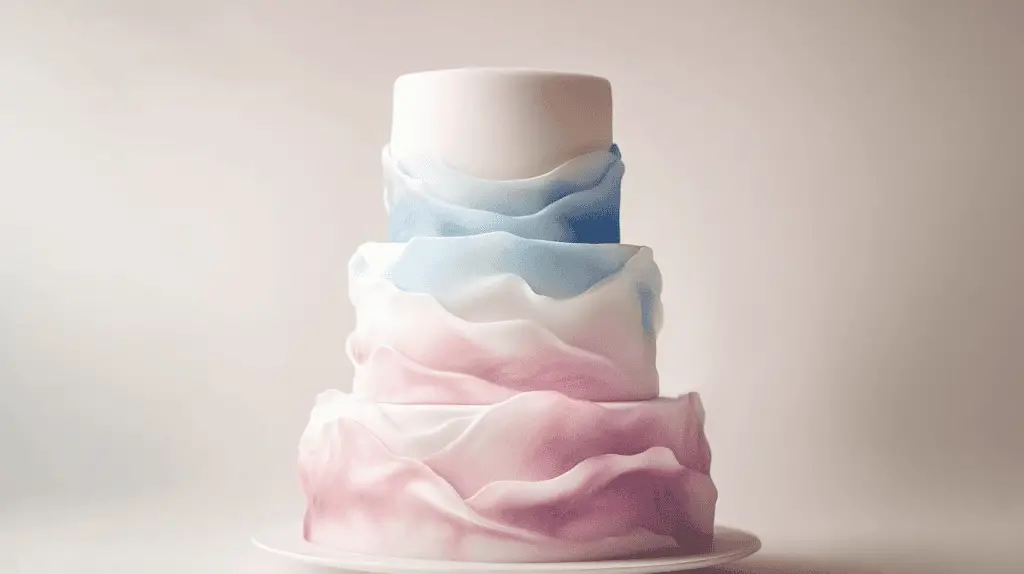
Opalite Wedding Cake Designs Overview
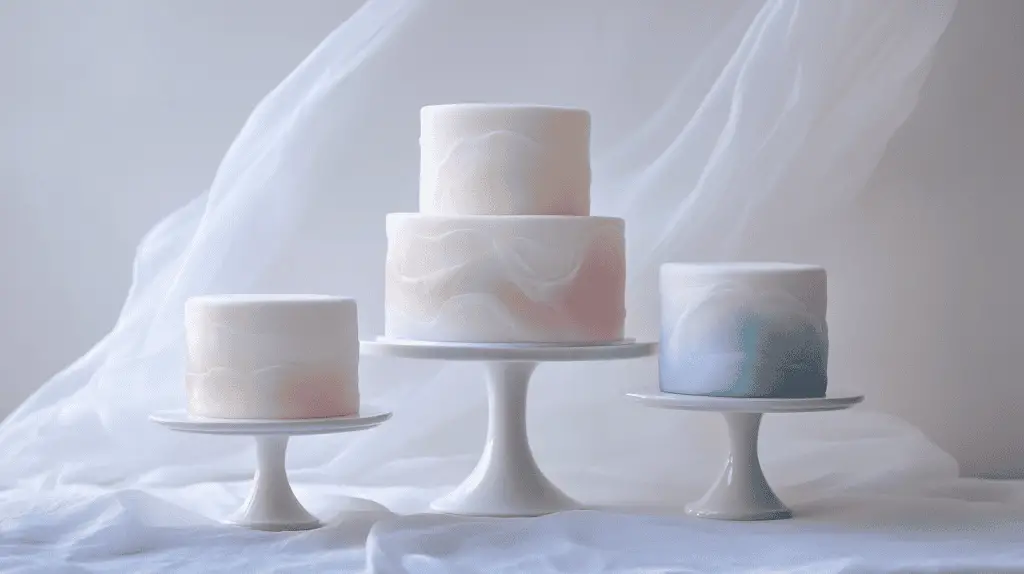
Opalite creates stunning translucent effects that transform traditional wedding cakes into ethereal centrepieces. This synthetic stone offers unique colour-shifting properties and pairs beautifully with various wedding themes through specific colour palettes and design techniques.
What Makes Opalite Unique for Wedding Cakes
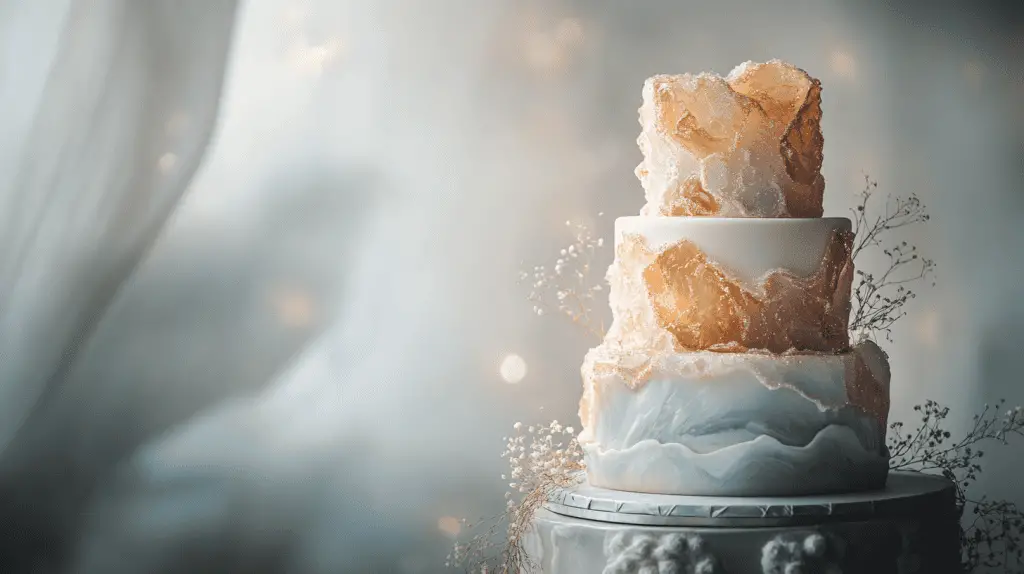
Opalite’s translucent quality creates a distinctive milky appearance that shifts between blue and amber hues depending on lighting conditions. This colour-changing property makes it particularly striking for evening receptions.
The stone’s smooth surface reflects light beautifully when recreated in fondant or sugar work. Cake designers achieve the opalite effect using pearl dust, edible glitter, and translucent sugar sheets layered together.
Key characteristics include:
- Semi-transparent appearance with internal luminosity
- Colour shifts from pale blue to golden amber
- Natural-looking veining patterns
- Subtle iridescent finish
The material works exceptionally well for geode cake designs. Sugar artists can create realistic opalite crystals using isomalt and food colouring that mimics the stone’s natural properties.
Popular Opalite Colour Palettes
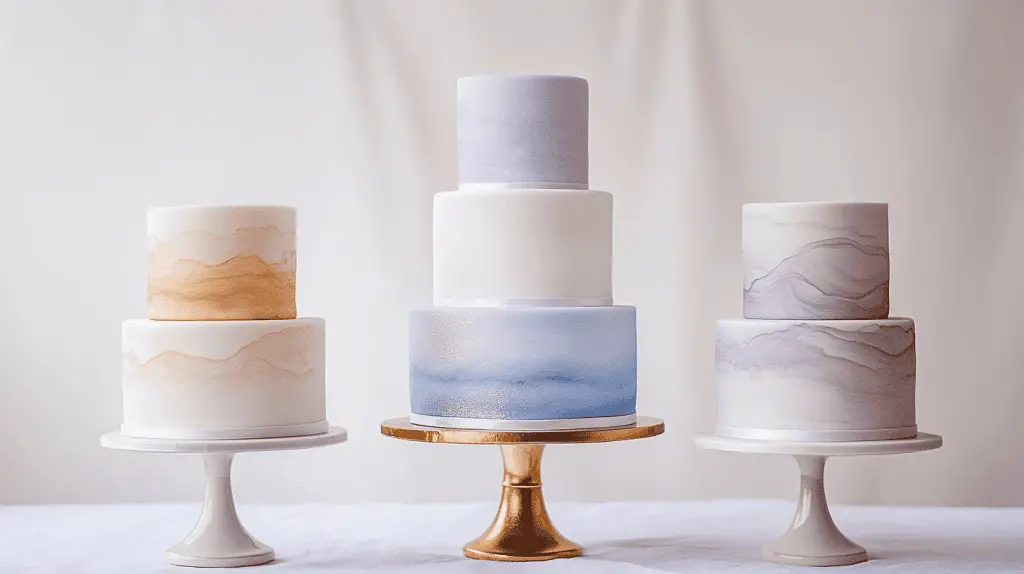
The most sought-after opalite wedding cake palette combines soft blues with warm amber tones. This creates depth and visual interest whilst maintaining an elegant appearance.
Popular colour combinations include:
- Pale blue and pearl white
- Dusty lavender with golden highlights
- Soft grey-blue with champagne accents
- Cream base with iridescent blue undertones
Many couples choose opalite colours to complement their wedding flowers. Dusty blue opalite pairs beautifully with white roses and eucalyptus. Amber-toned opalite works well with blush peonies and gold accents.
The translucent effect requires specific techniques. Bakers use airbrushing with pearl lustre to achieve the characteristic opalite shimmer. Multiple thin layers create the stone’s natural depth.
How to Incorporate Opalite into Cake Themes
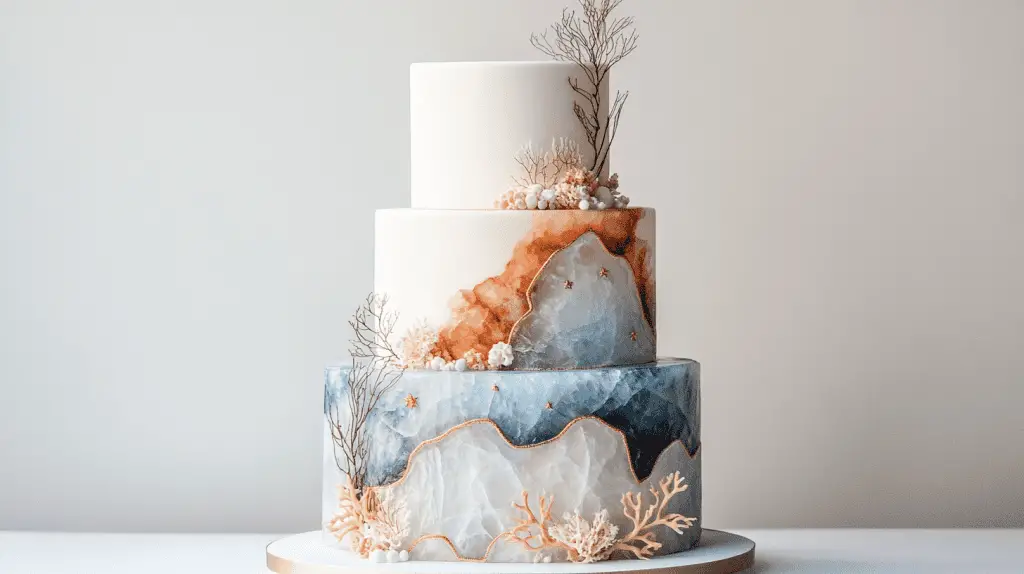
Bohemian weddings benefit from opalite geode sections combined with dried flowers and macramé-inspired piping. The stone’s natural appearance complements rustic venues perfectly.
Modern minimalist themes showcase opalite through clean geometric designs. Single-tier cakes with smooth opalite panels create sophisticated focal points without overwhelming decorative elements.
Beach and coastal themes naturally incorporate opalite’s oceanic blue tones. Designers often combine opalite effects with sugar coral and pearl details for cohesive seaside aesthetics.
Garden party weddings feature opalite accents alongside fresh flowers and greenery. The stone’s subtle colours don’t compete with natural botanical elements whilst adding contemporary flair.
Celestial themes pair opalite with gold stars and moon phases. The stone’s luminous quality enhances space-inspired designs for couples seeking unique astronomical motifs.
1. Opalite Watercolour Ombre
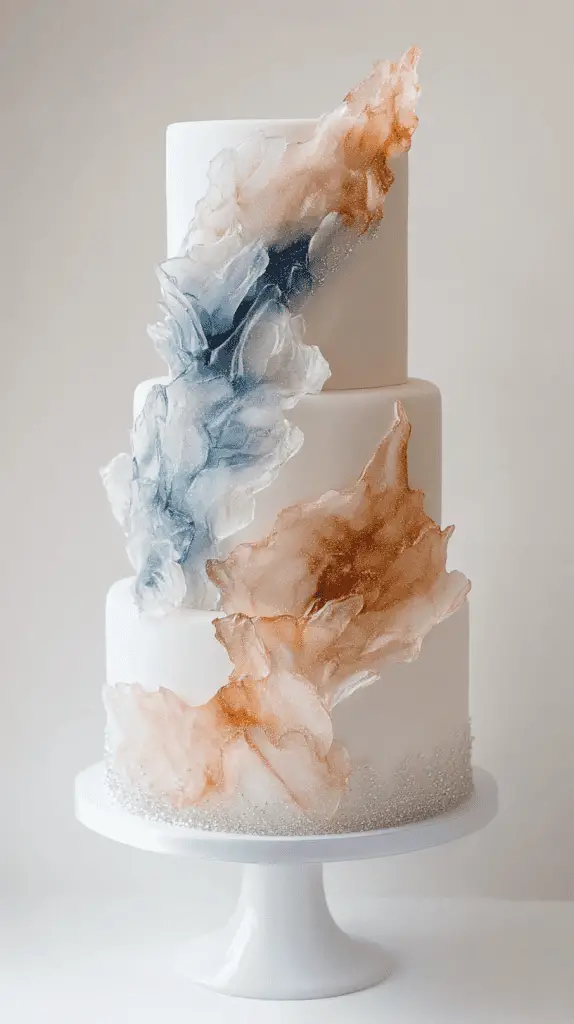
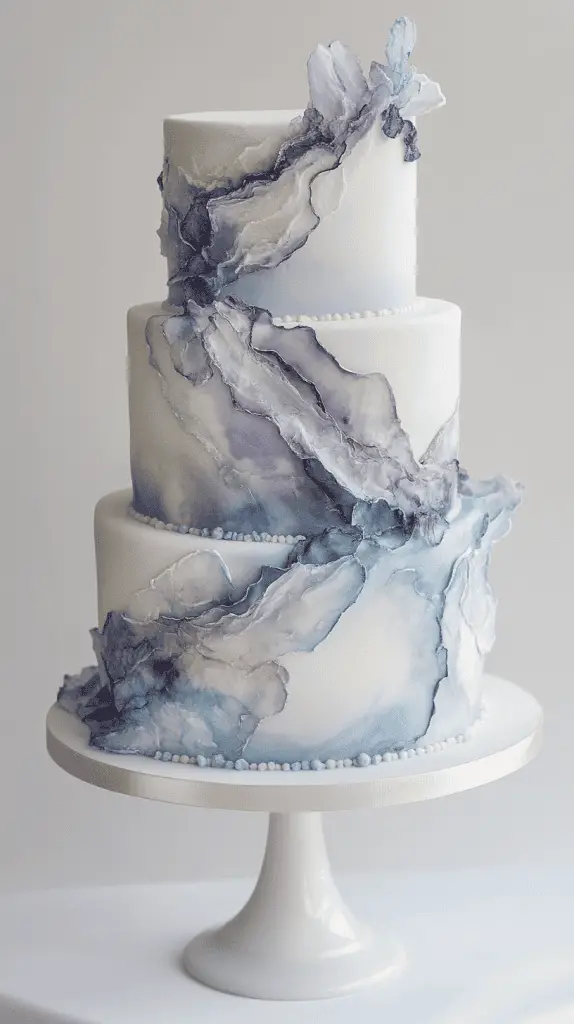
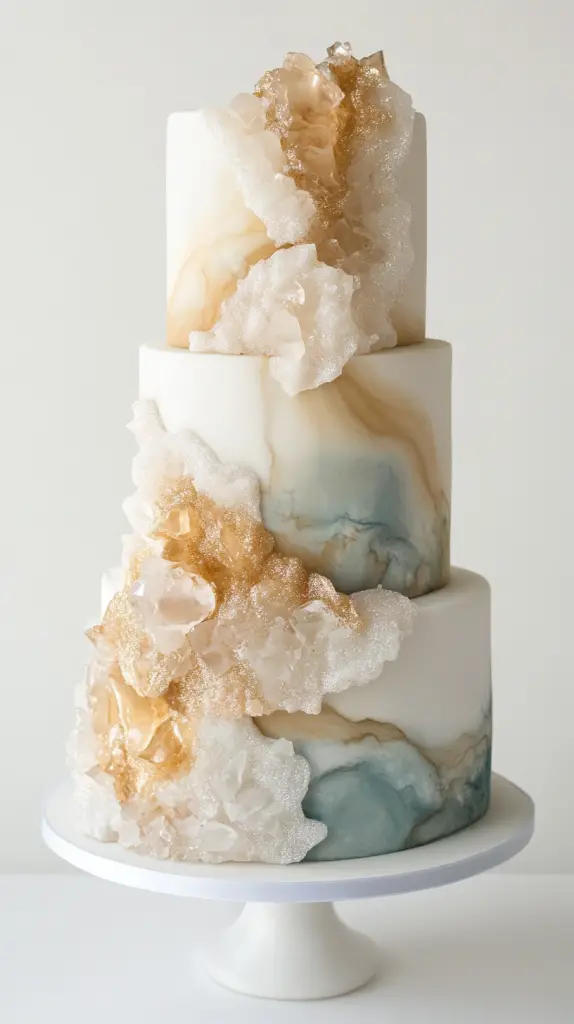
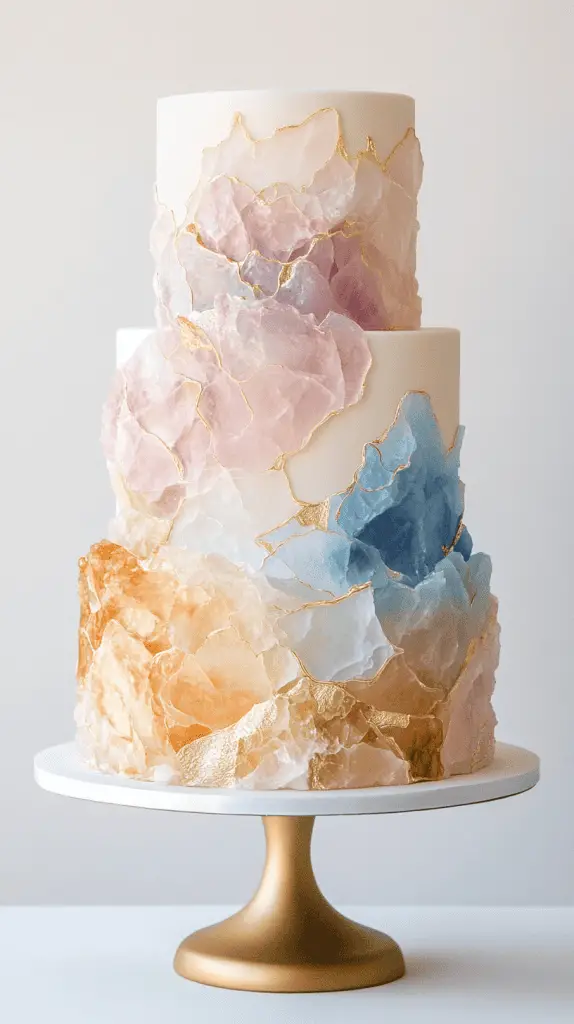
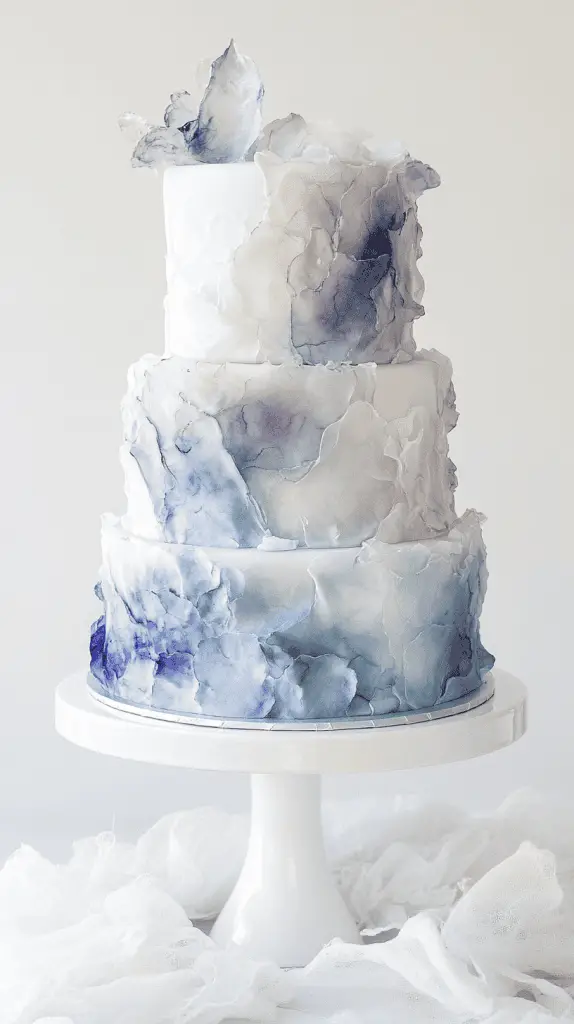
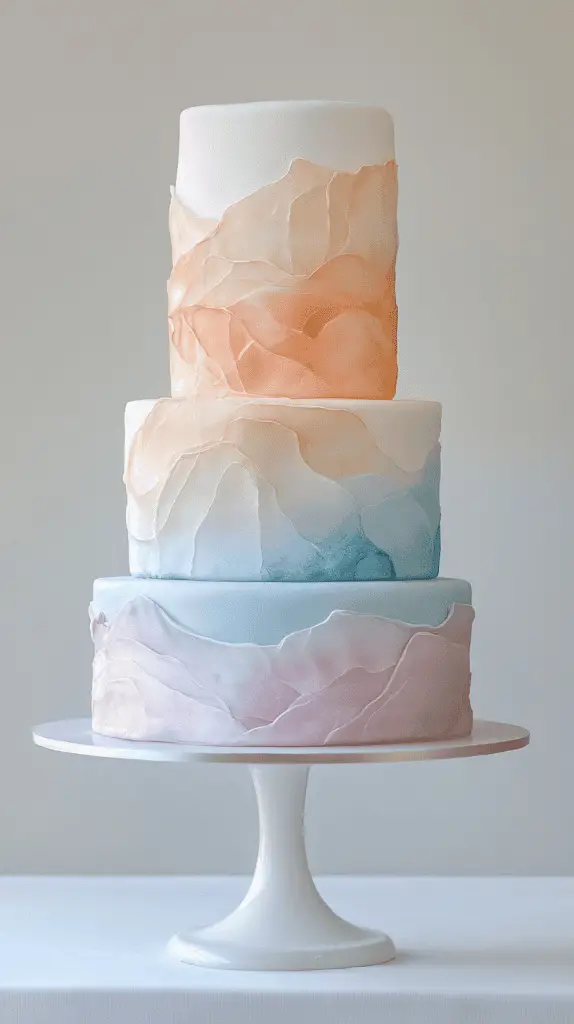
Opalite watercolour ombre wedding cakes combine the mystical beauty of opalite gemstones with soft, artistic gradients. These designs feature translucent layers that mirror opalite’s characteristic milky appearance and subtle colour shifts.
The technique involves hand-painting delicate washes of colour across fondant or buttercream surfaces. Bakers typically use edible pearl dust mixed with clear alcohol to create the signature opalescent effect.
Popular colour combinations include:
- Soft blues transitioning to creamy whites
- Pale pinks blending into lavender hues
- Mint greens flowing into pearl tones
- Golden champagne fading to ivory
The watercolour application creates organic, flowing patterns that resemble natural opalite formations. Each brushstroke adds depth and movement to the cake’s surface.
Textural elements enhance the opalite effect through subtle ruffles or smooth fondant work. The key lies in maintaining the stone’s characteristic soft luminosity rather than harsh colour transitions.
These cakes work exceptionally well for couples seeking a mystical or bohemian wedding theme. The opalescent finish catches light beautifully in both natural and artificial lighting conditions.
Professional cake artists often incorporate edible glitter sparingly to replicate opalite’s inner glow. The watercolour technique allows for unique, unrepeatable patterns on each tier.
The finished result appears almost ethereal, with colours that seem to shift and change depending on viewing angle. This creates an enchanting centrepiece that captures opalite’s magical qualities whilst maintaining elegant sophistication.
2. Faceted Opalite Gemstone Cuts
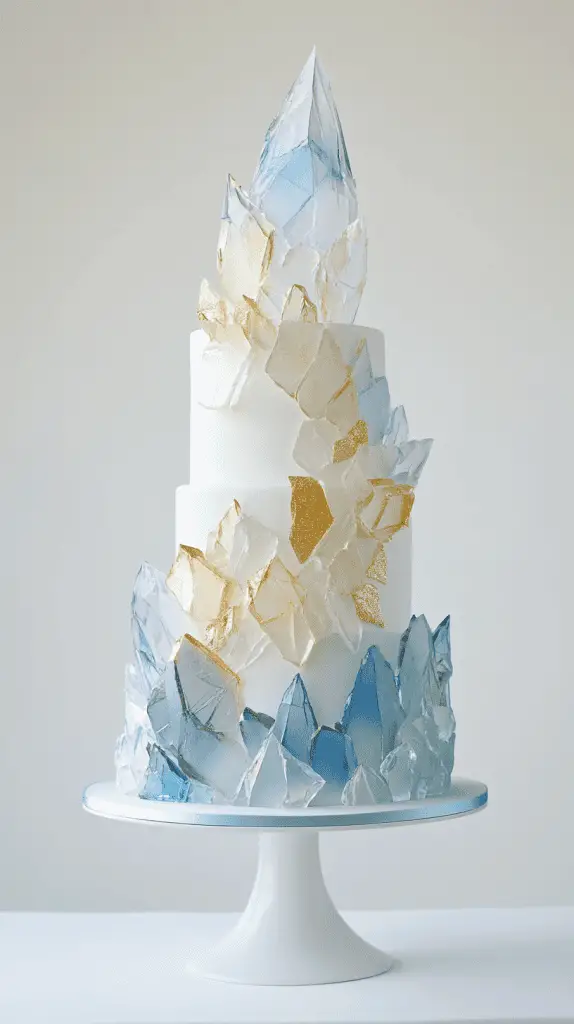
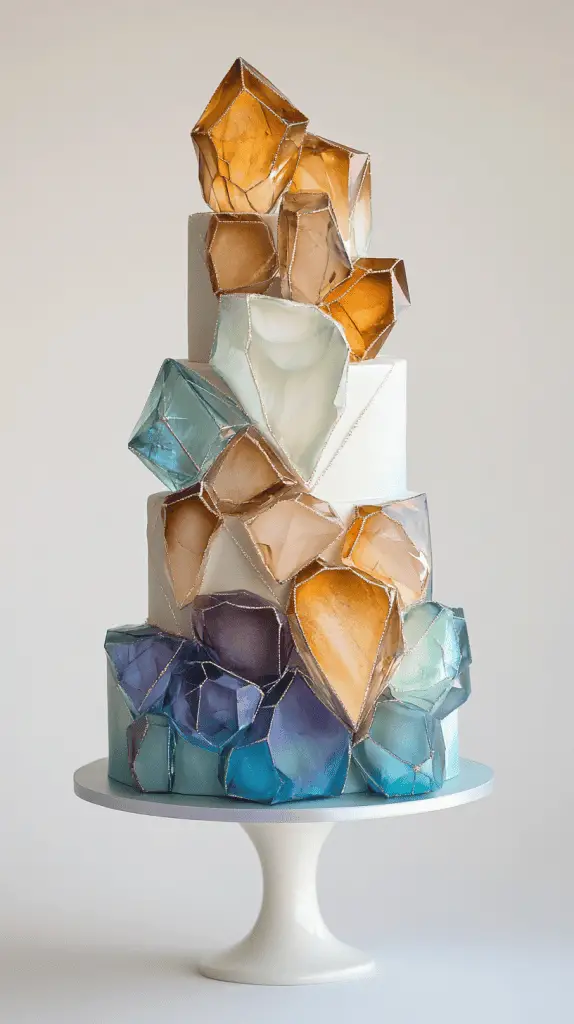
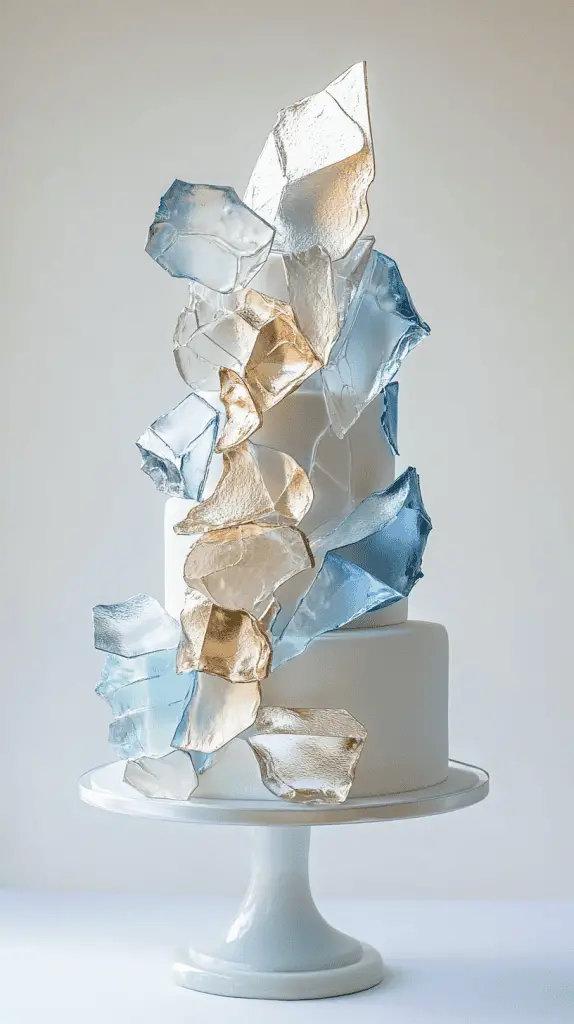
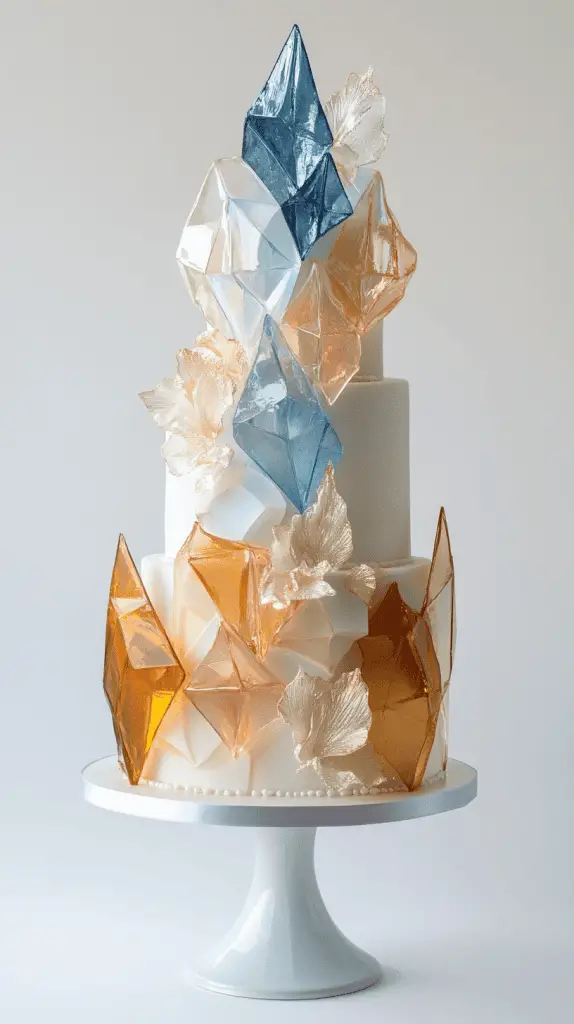
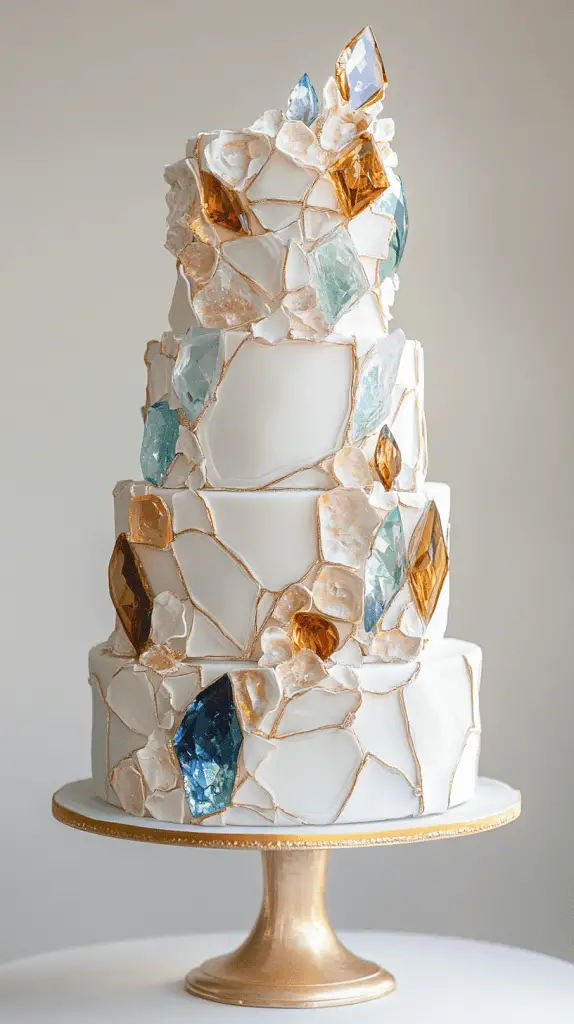
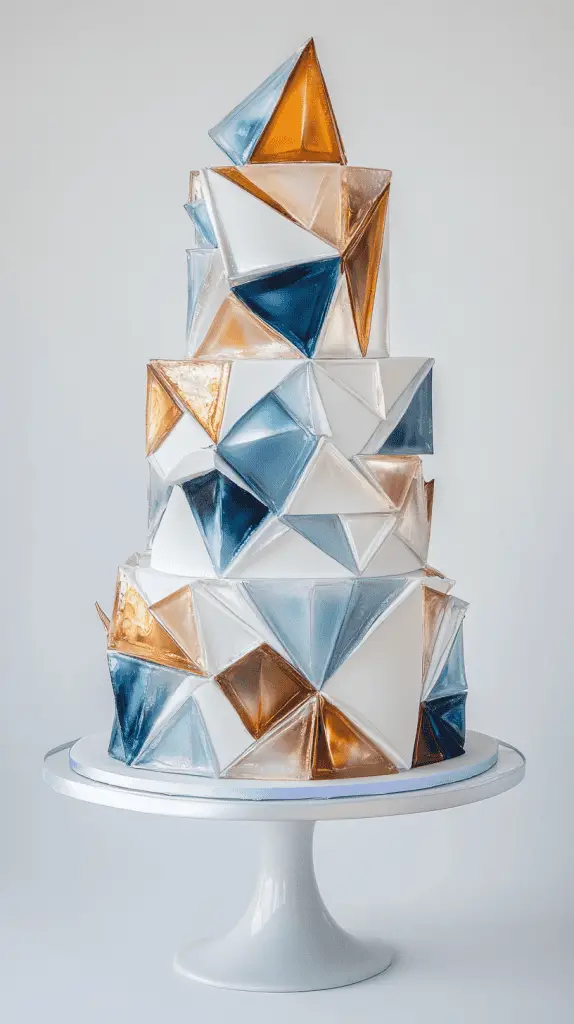
Faceted opalite creates stunning geometric patterns that enhance wedding cake designs through precise light reflection. The synthetic material responds beautifully to traditional gem cutting techniques.
Brilliant cuts maximise opalite’s natural luminescence with triangular and kite-shaped facets radiating from the centre. These cuts produce exceptional sparkle under wedding venue lighting.
Step cuts feature rectangular facets arranged in parallel rows, creating elegant linear patterns. The emerald and asscher cuts work particularly well with opalite’s translucent properties.
Mixed cuts combine brilliant and step cutting techniques for unique visual effects. The crown may feature step facets whilst the pavilion displays brilliant cuts, or vice versa.
Popular faceted shapes for wedding cake decoration include:
- Round brilliant – Classic and versatile
- Princess cut – Square with brilliant faceting
- Emerald cut – Rectangular step cut
- Cushion cut – Square or rectangular with rounded corners
- Oval – Elongated brilliant cut
- Marquise – Boat-shaped brilliant cut
Each faceted opalite gemstone reflects light differently depending on its cut. The precise angles and proportions determine how effectively the stone captures and returns light.
Faceted opalite maintains consistent colour and clarity throughout the cutting process. The material’s synthetic nature eliminates natural inclusions that might affect traditional gemstones during faceting.
Wedding cake designers often select specific cuts to complement their overall aesthetic vision. Brilliant cuts suit glamorous themes, whilst step cuts enhance minimalist designs.
3. Marbled Opalite Accents
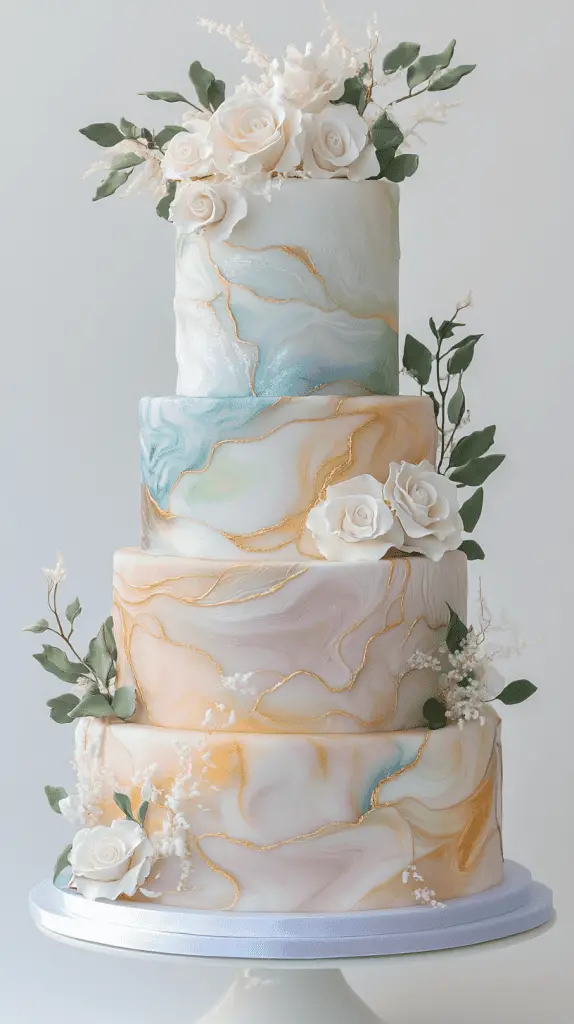
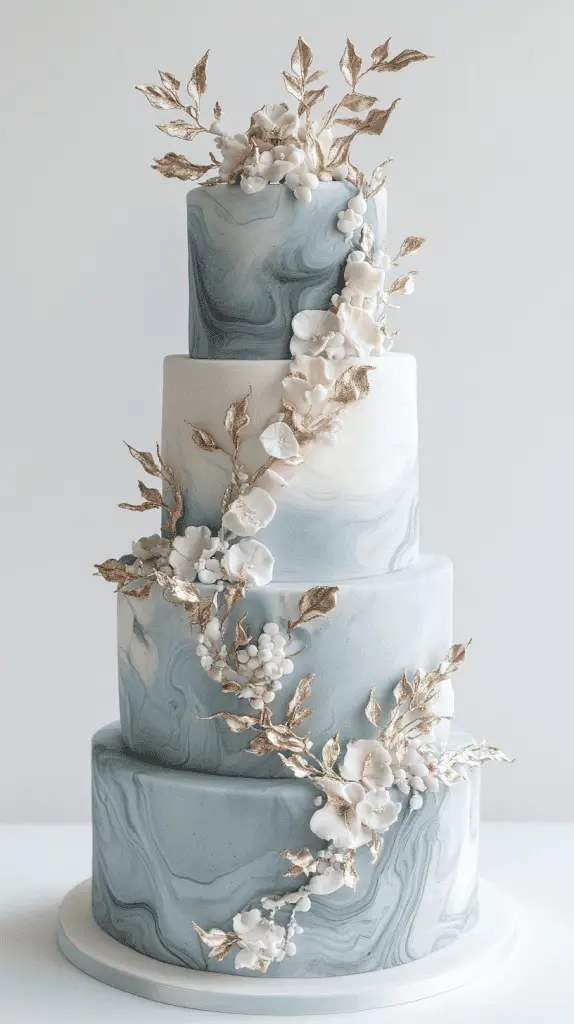
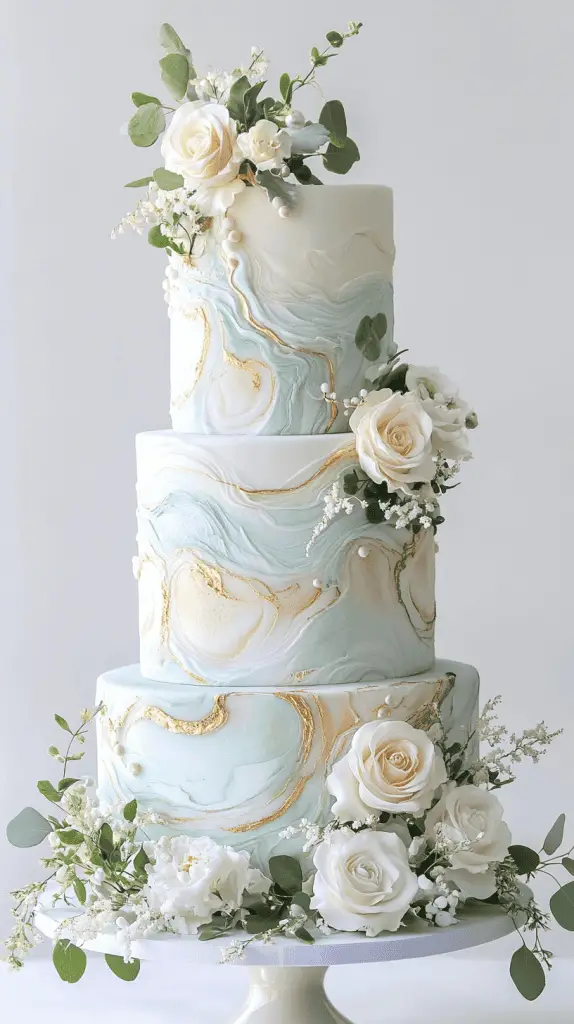
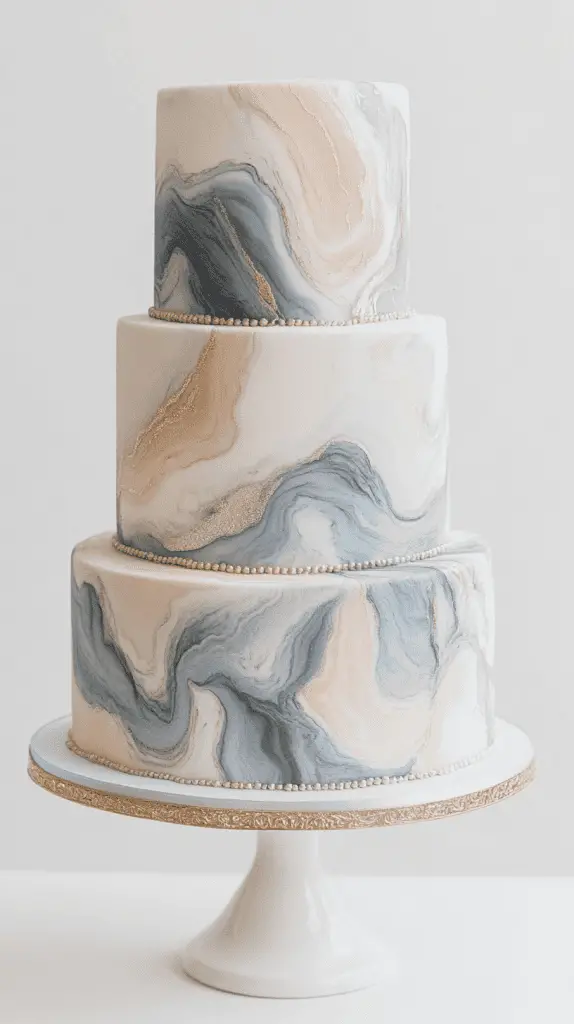
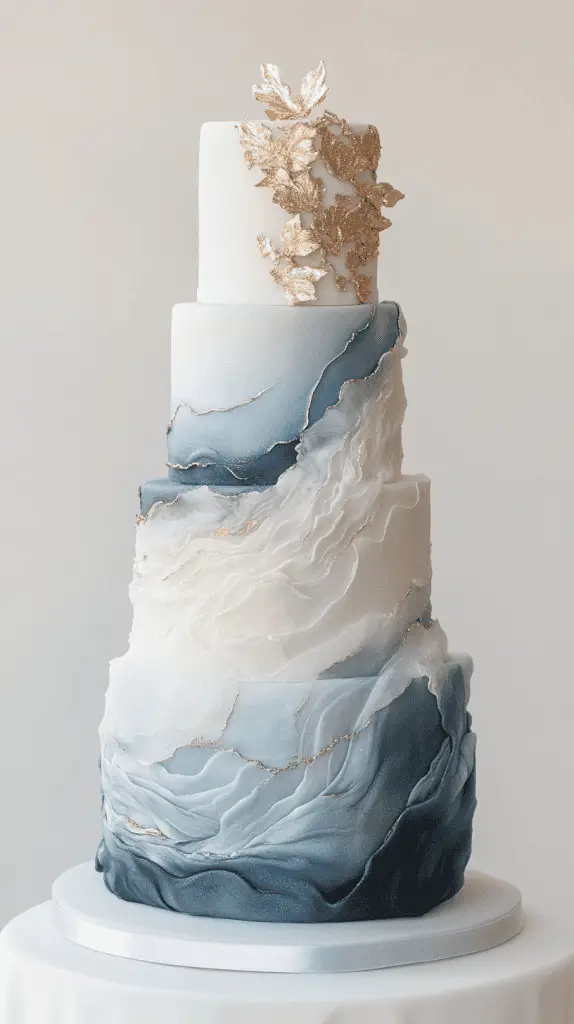
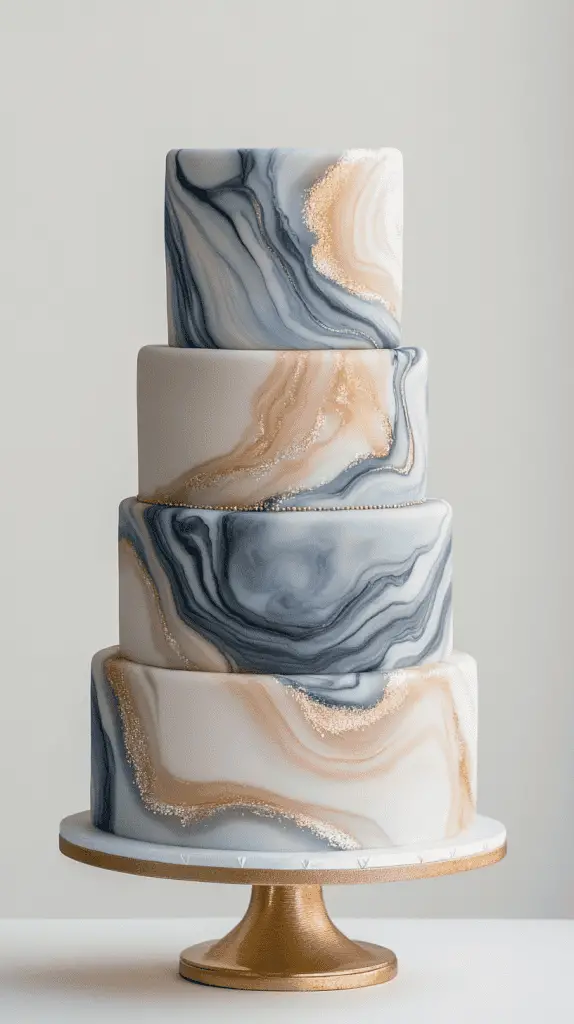
Marbled opalite accents create stunning visual texture on wedding cakes through their flowing, organic patterns. These decorative elements mimic the natural veining found in opalite gemstones whilst maintaining the stone’s characteristic translucent appearance.
Application Techniques
Bakers achieve marbled opalite effects using several methods:
- Swiss meringue buttercream with swirled colour techniques
- Fondant manipulation with pearlescent dusts
- Airbrushing gradients over textured surfaces
- Hand-painted veining with edible metallics
Colour Combinations
The most effective marbled opalite designs incorporate soft blues, whites, and subtle pinks. These colours blend naturally to replicate opalite’s gentle luminescence. Gold and silver accents enhance the marbled patterns without overwhelming the delicate base colours.
Design Placement
Marbled accents work particularly well on specific cake areas. Single tiers can feature full marbled coverage, whilst multi-tier designs benefit from alternating plain and marbled sections. The technique creates striking contrast when paired with smooth, solid-coloured tiers.
Complementary Elements
Fresh flowers and greenery enhance marbled opalite designs without competing for attention. Eucalyptus, white roses, and dusty miller pair exceptionally well with the soft colour palette. Metallic cake toppers and edible pearls add sophistication.
Professional decorators often combine marbled techniques with other opalite-inspired elements. This layered approach creates depth whilst maintaining the stone’s ethereal quality throughout the entire cake design.
4. Touch of Opalite with Edible Jewels
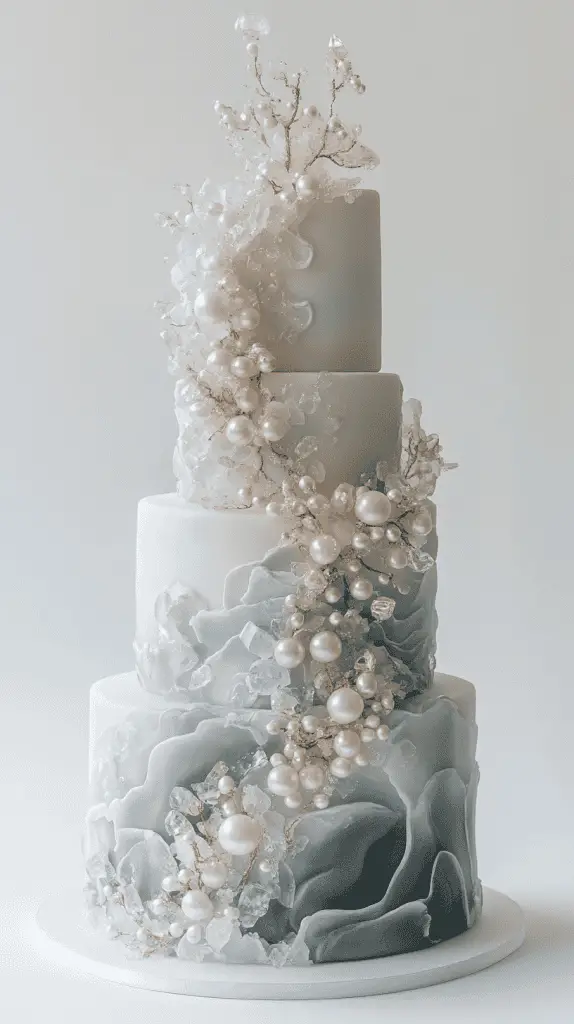
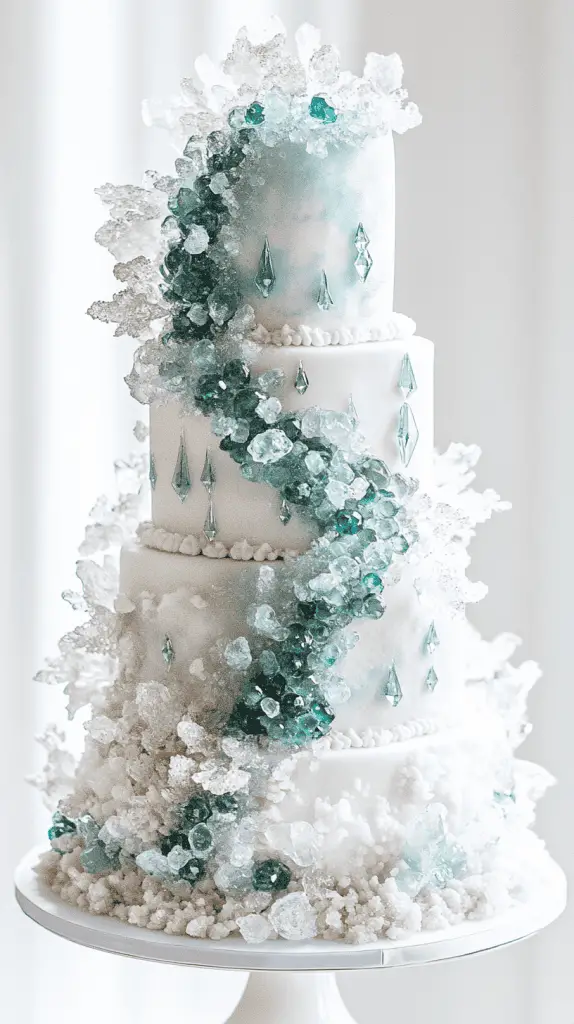
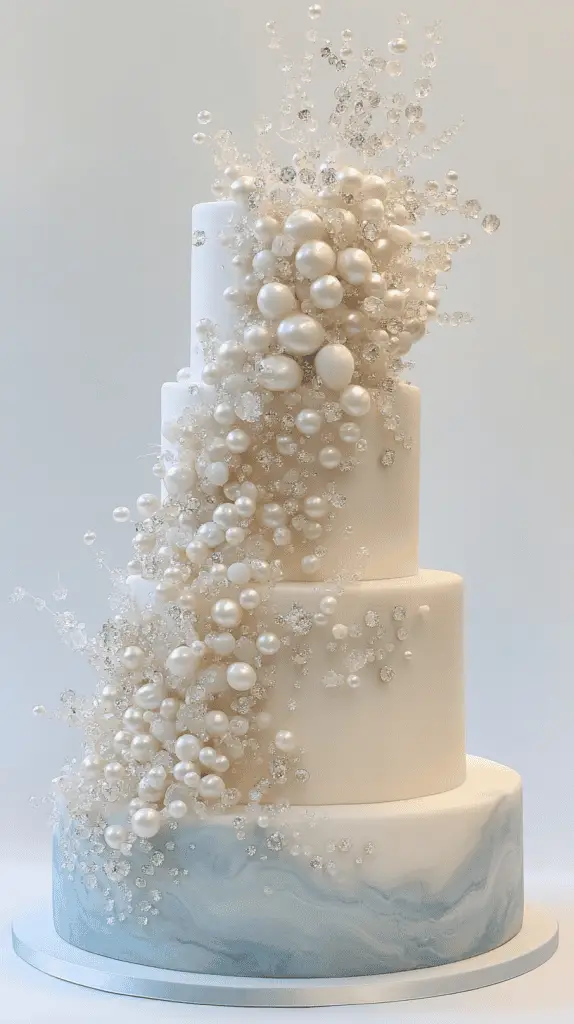
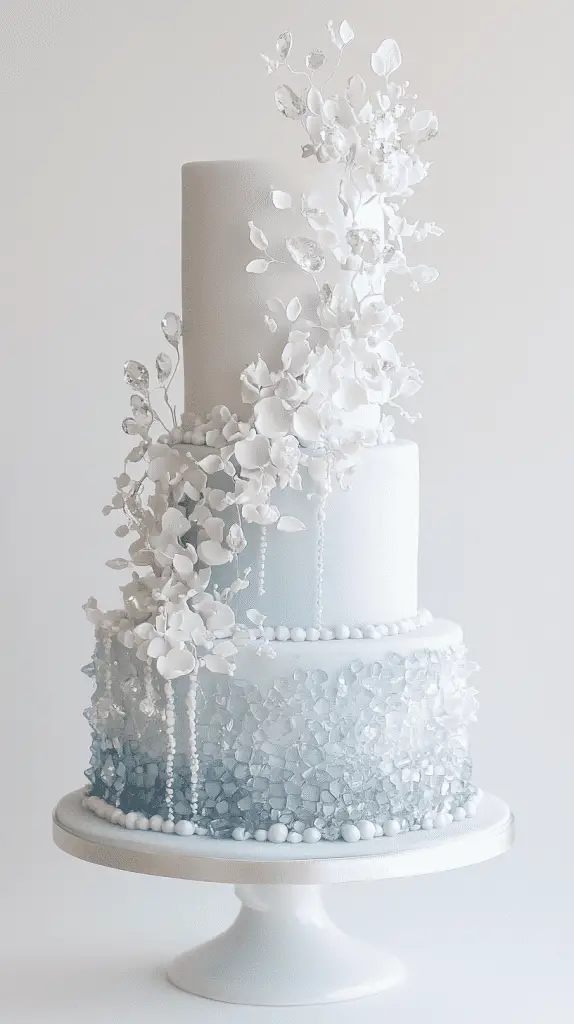
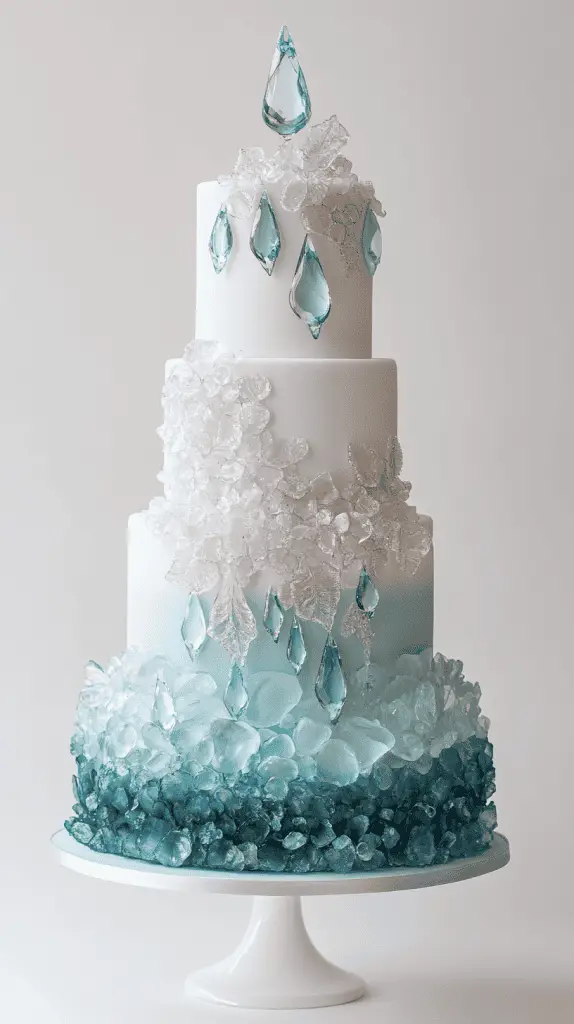
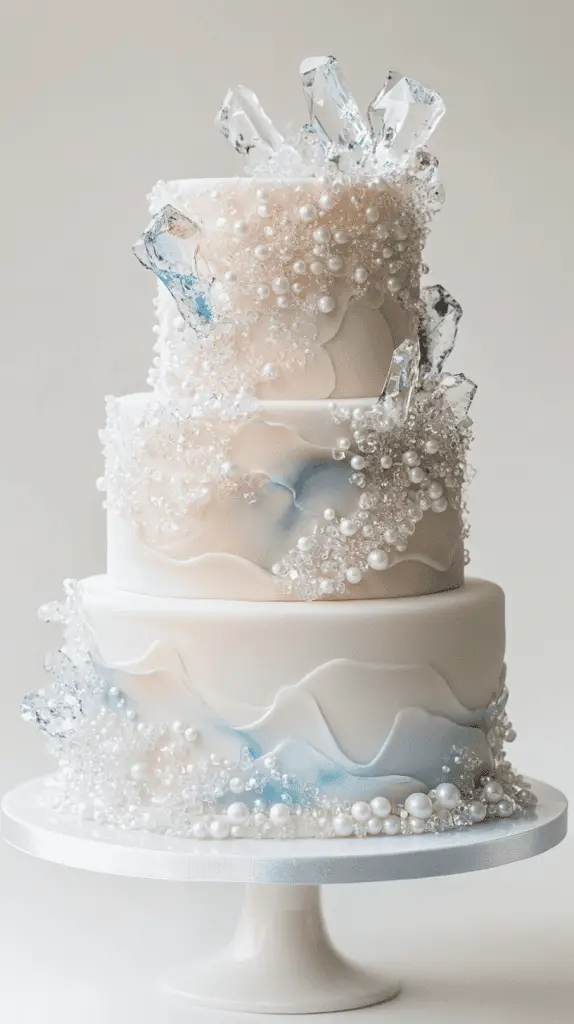
Opalite wedding cakes gain remarkable depth when paired with edible jewels that complement the stone’s natural shimmer. These decorative elements create stunning focal points whilst maintaining the cake’s ethereal quality.
Isomalt crystals work exceptionally well alongside opalite decorations. They can be tinted with food colouring to match the opalite’s blue and white tones. The crystals catch light similarly to real gemstones.
Sugar glass provides another excellent option for edible jewels. Bakers can create various shapes including diamonds, emeralds, and teardrops. These pieces add texture without overwhelming the opalite’s subtle beauty.
| Edible Jewel Type | Best Placement | Colour Options |
| Isomalt crystals | Cake borders | Clear, blue, white |
| Sugar glass gems | Between cake tiers | Translucent tones |
| Fondant pearls | Cascading designs | White, cream |
Fondant pearls create elegant cascades when combined with opalite elements. They should be dusted with pearl lustre dust for authentic shine. Position them to flow naturally down the cake’s side.
Rock candy offers a more organic approach to edible jewels. Clear or lightly tinted pieces mimic natural crystal formations. They work particularly well on rustic-style opalite cakes.
The key lies in balancing proportions between opalite stones and edible jewels. Too many decorative elements can create visual chaos. Strategic placement ensures each component enhances the overall design rather than competing for attention.
5. Opalite Geode Veins & Crystal Inlays
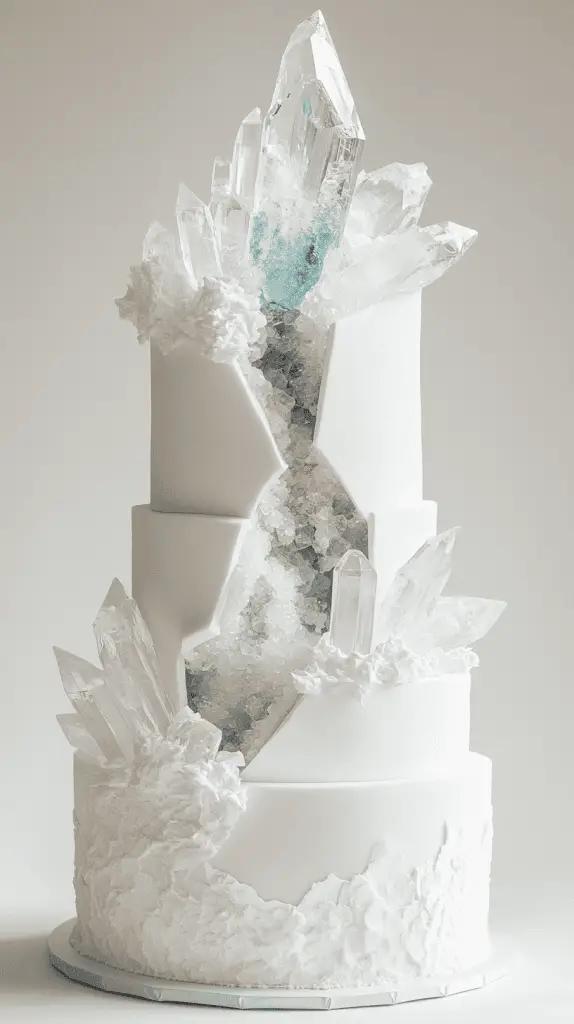
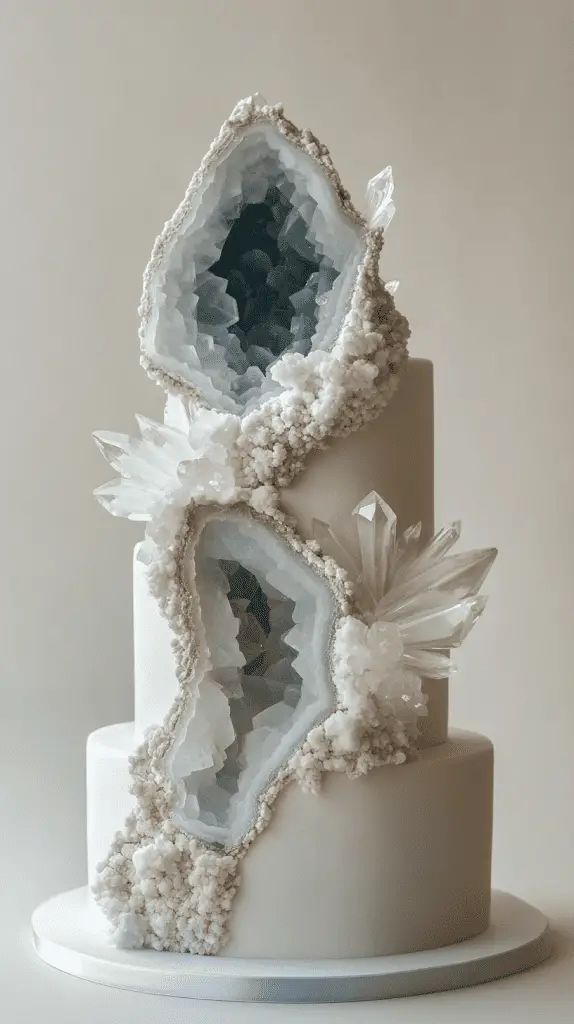
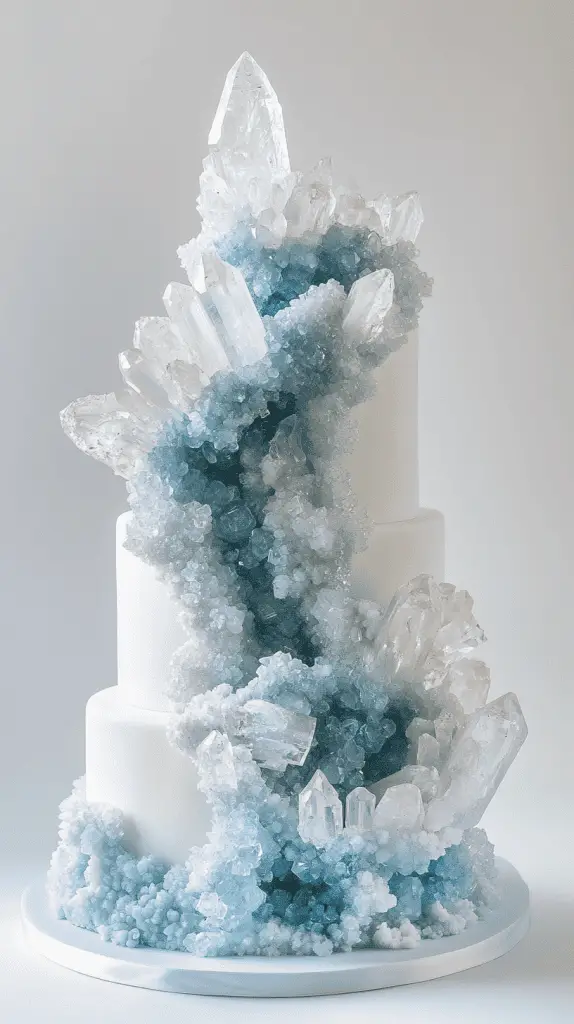
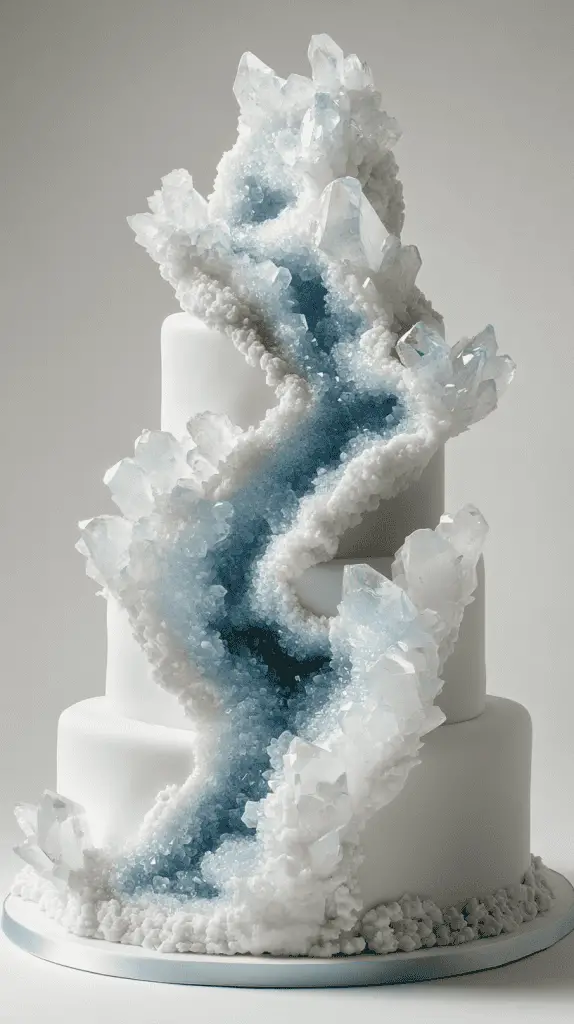
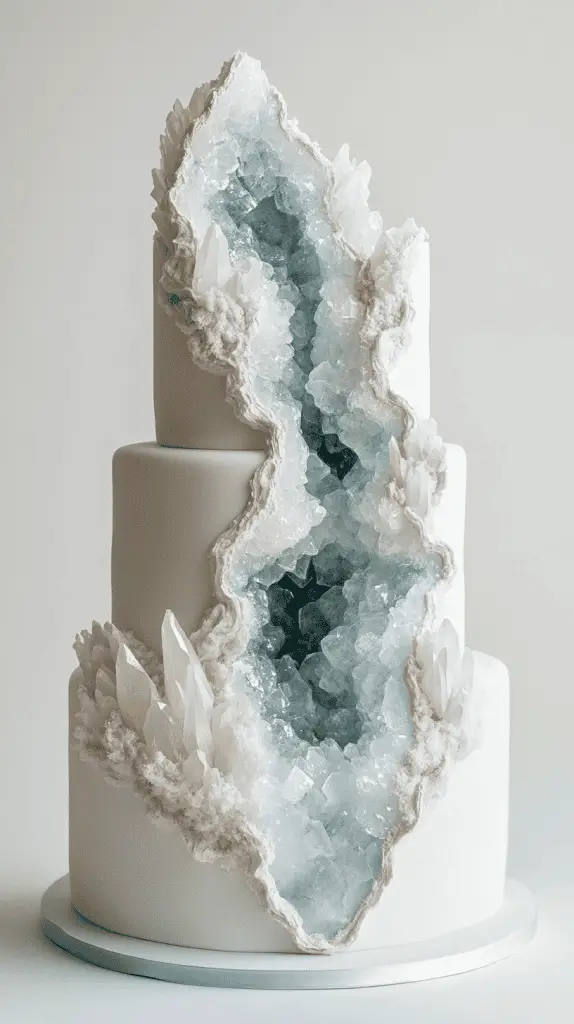
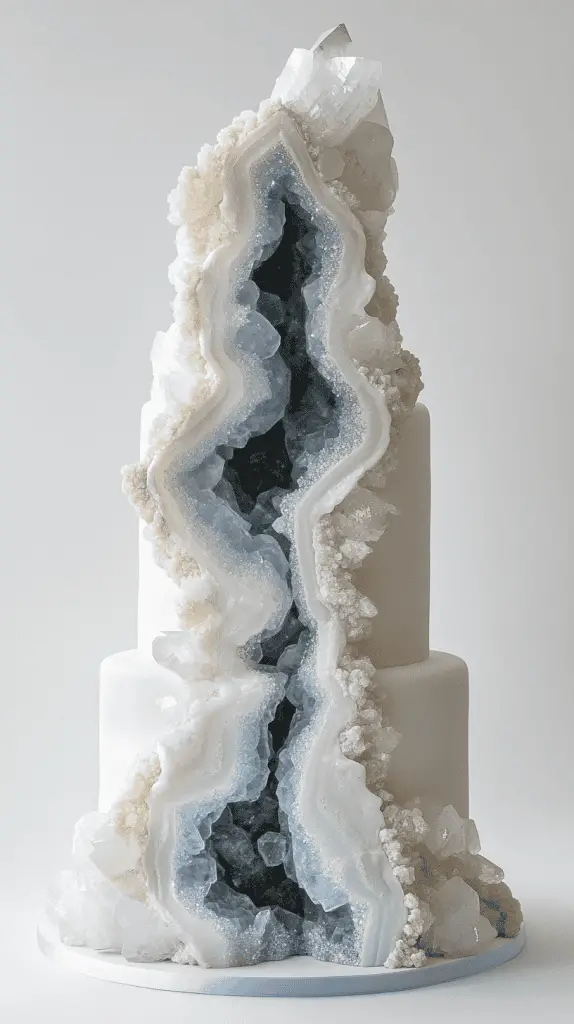
Opalite geode veins create stunning visual depth in wedding cakes through their translucent, milky appearance. The man-made glass material mimics natural opal with its soft blue and white hues.
Bakers achieve realistic geode effects by layering opalite pieces within carved cake sections. The translucent quality allows light to filter through, creating an authentic crystal appearance.
Popular placement techniques include:
- Horizontal fault lines through cake tiers
- Vertical crystal veins along cake sides
- Geometric cutout sections filled with opalite
- Scattered inlay pieces across fondant surfaces
The milky white to pale blue colouration of opalite complements various wedding themes. It works particularly well for winter ceremonies and celestial-themed celebrations.
Crystal inlays require careful planning during cake construction. Bakers must create stable cavities that support the opalite pieces without compromising structural integrity.
Edible alternatives include sugar glass tinted to match opalite’s appearance. These provide similar visual impact whilst remaining completely consumable.
Key design considerations:
- Size proportion relative to cake tiers
- Weight distribution for multi-tier stability
- Colour coordination with wedding palette
- Safe removal instructions for guests
Professional cake designers often combine opalite with other crystal elements. This creates dynamic geode formations that appear naturally occurring rather than artificially placed.
The subtle iridescence of opalite catches photography lighting beautifully. This makes it an excellent choice for couples prioritising stunning wedding photographs.
6. Isomalt “Opalite Glass” Sails
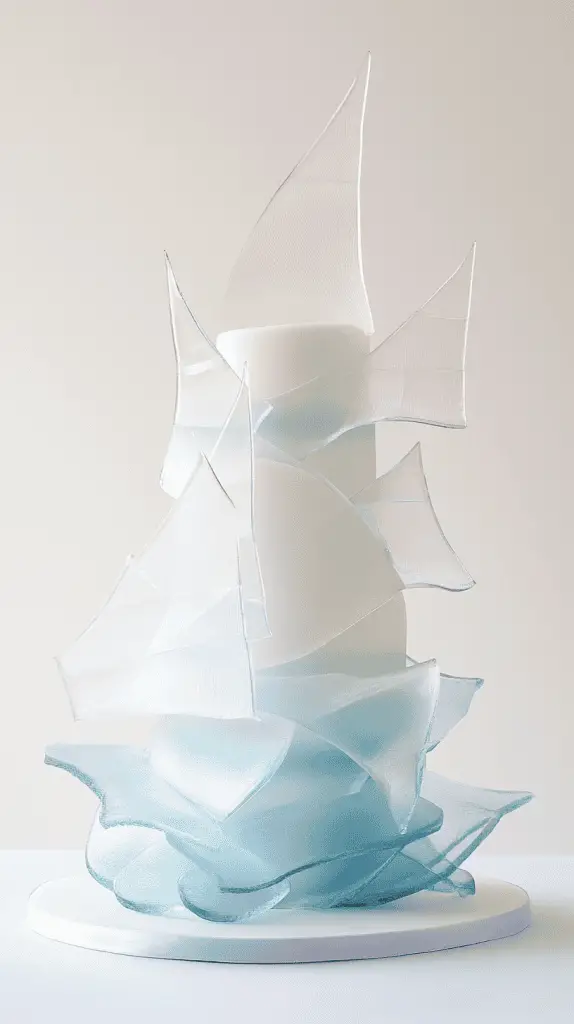
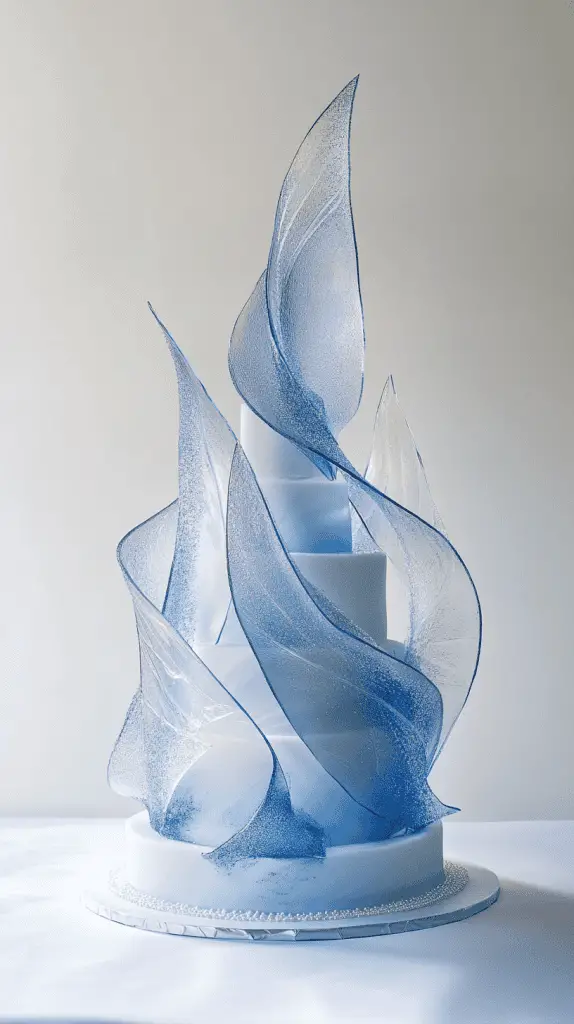
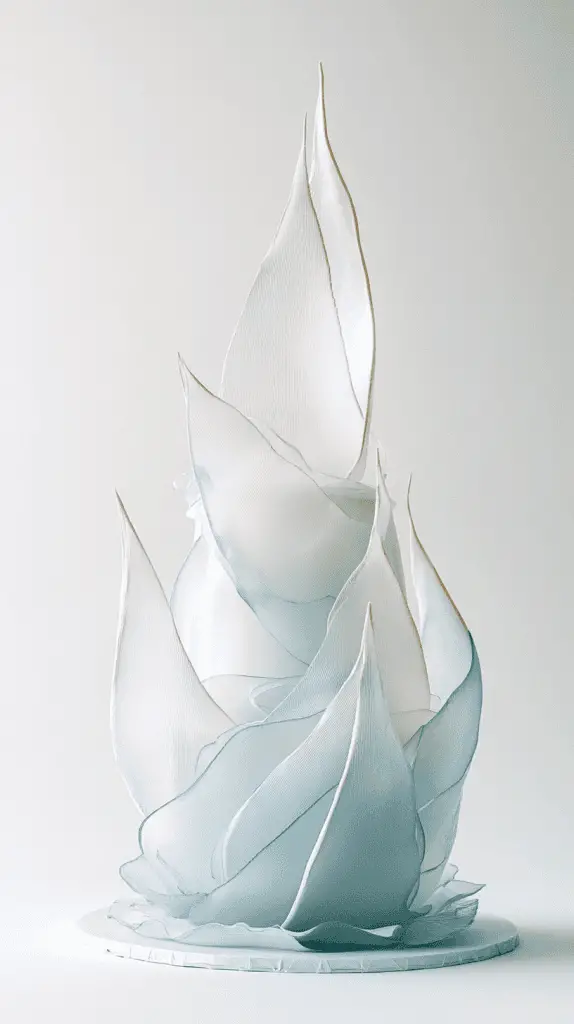
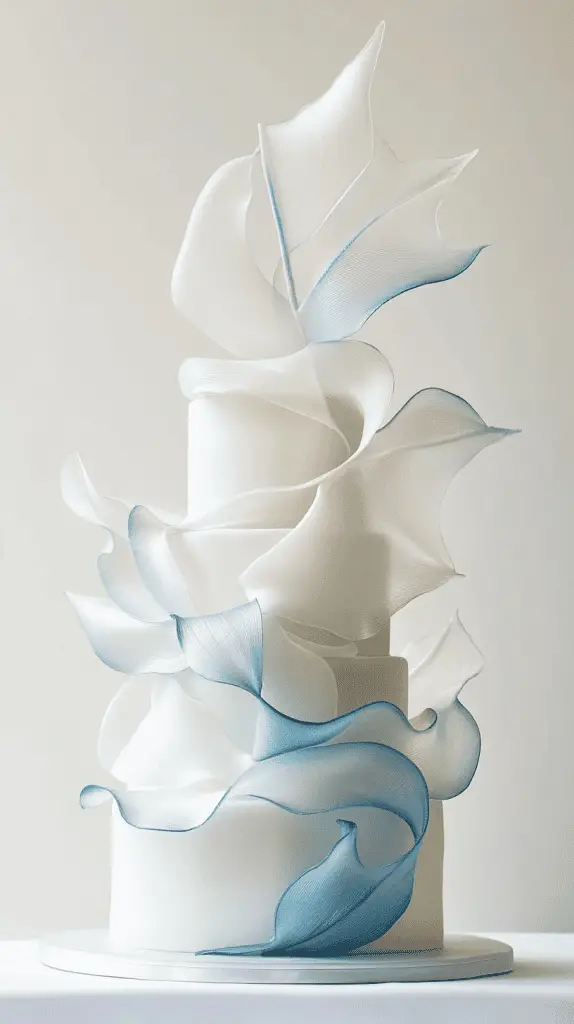
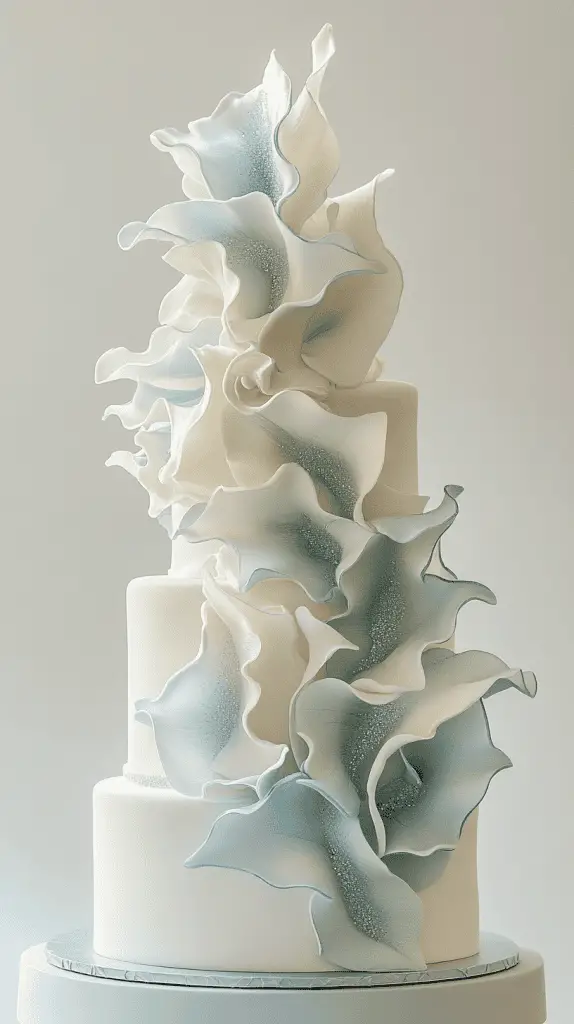
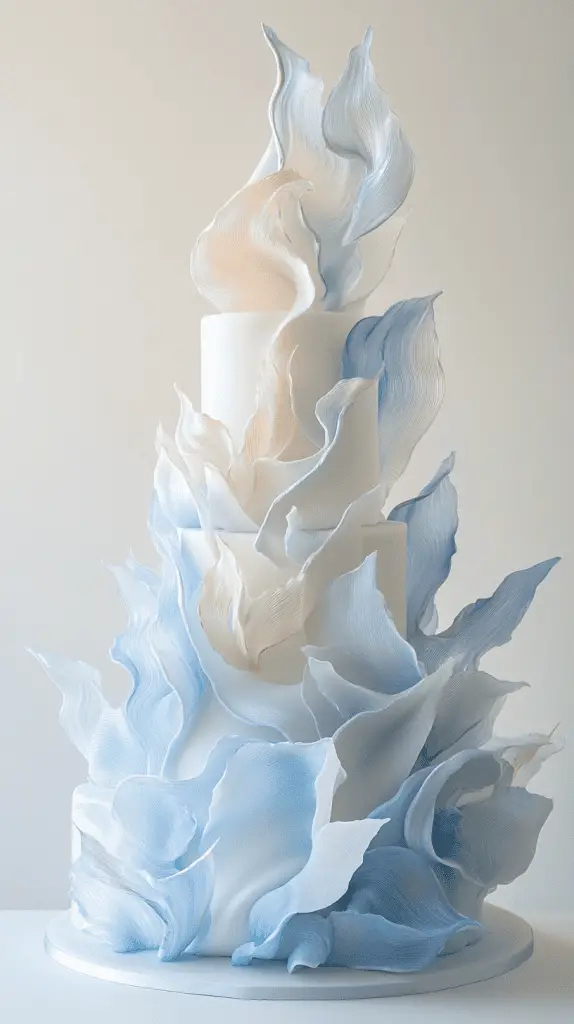
Isomalt creates stunning translucent decorations that mimic opalite’s distinctive milky-blue appearance. Cake decorators achieve this ethereal effect by carefully controlling temperature and cooling techniques during the sugar work process.
Creating the Opalite Effect
The key lies in achieving partial opacity whilst maintaining translucency. Professional bakers add white food colouring in minute quantities to clear isomalt syrup. A touch of pearl lustre dust enhances the opalescent quality that makes these sails so captivating.
Shaping Techniques
| Method | Temperature | Result |
| Bubble technique | 160°C | Organic curves |
| Mould pouring | 150°C | Consistent shapes |
| Free-form pulling | 140°C | Artistic variance |
Decorators work quickly once the isomalt reaches the proper consistency. The sugar glass becomes pliable enough to shape into flowing sail forms that catch light beautifully.
Positioning and Support
These delicate elements require internal wire armatures for stability. Food-safe floral wire gets inserted whilst the isomalt remains workable but not scorching hot.
Professional decorators often create multiple sail sizes for layered visual depth. Smaller sails complement larger focal pieces without overwhelming the overall composition.
Colour Variations
Some bakers incorporate subtle blue tinting alongside the white base. Others prefer pure translucency with only pearl effects. The choice depends on the specific opalite aesthetic desired for each wedding cake design.
7. Wafer-Paper Opalite Veils & Ruffles
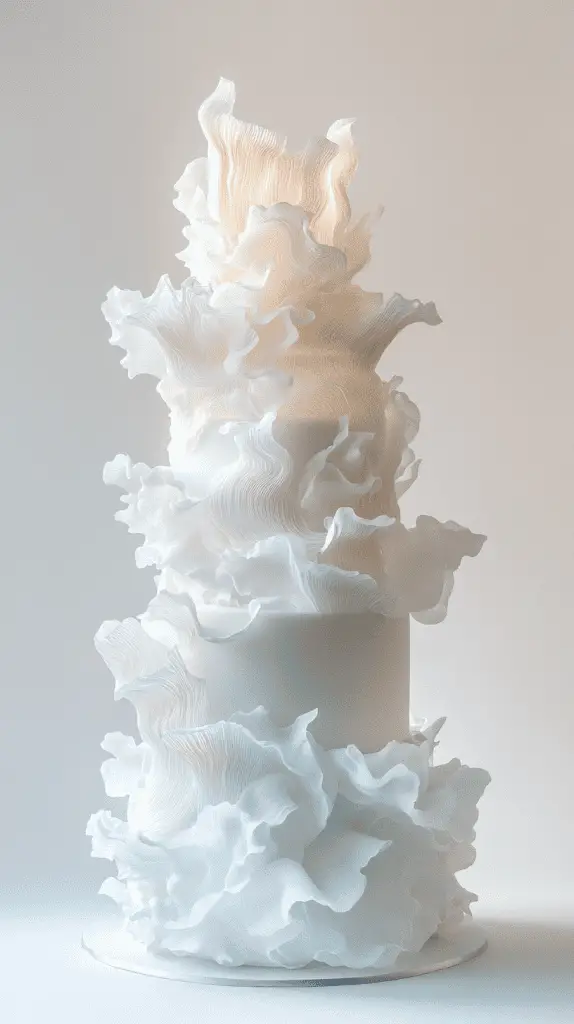
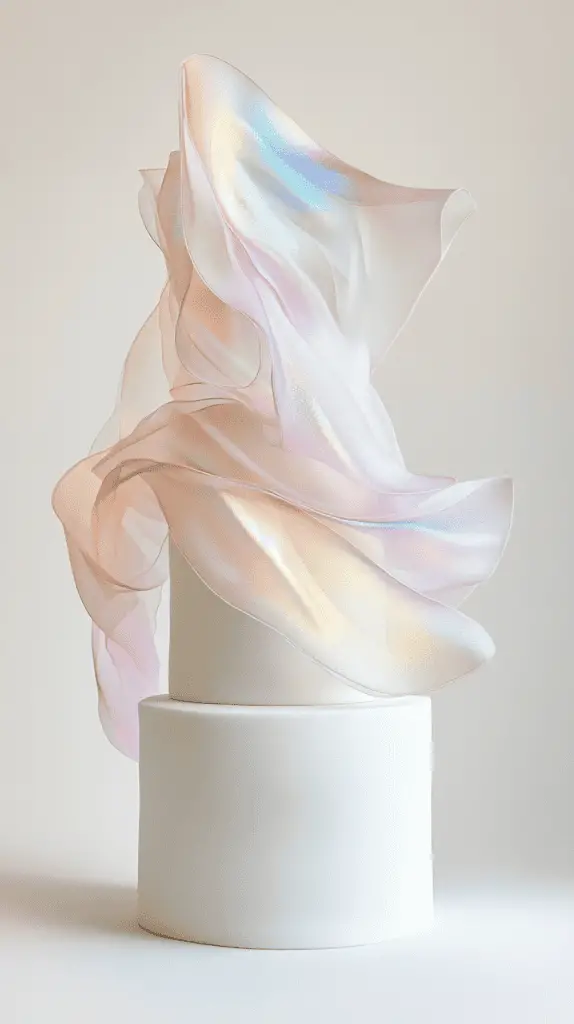
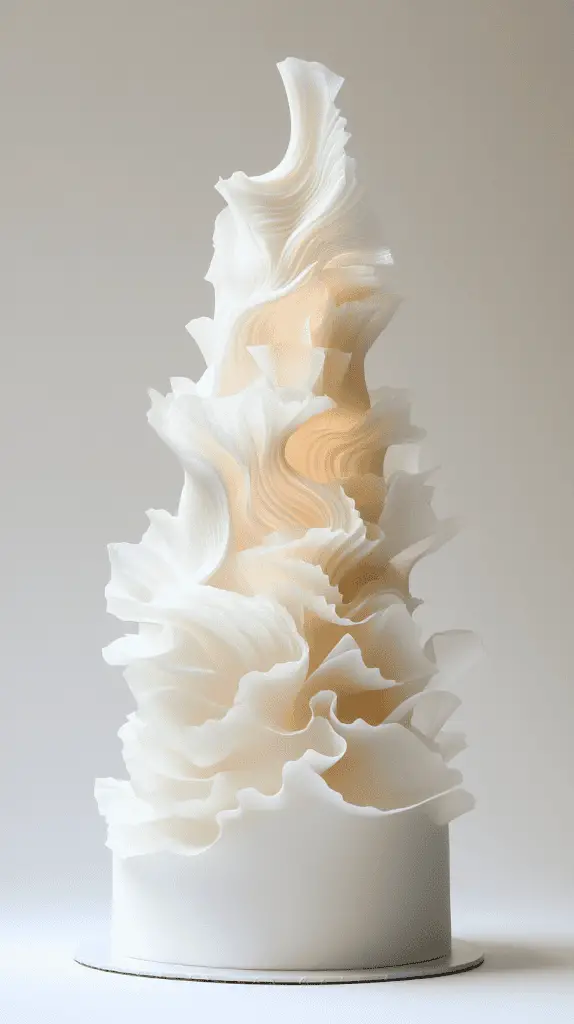
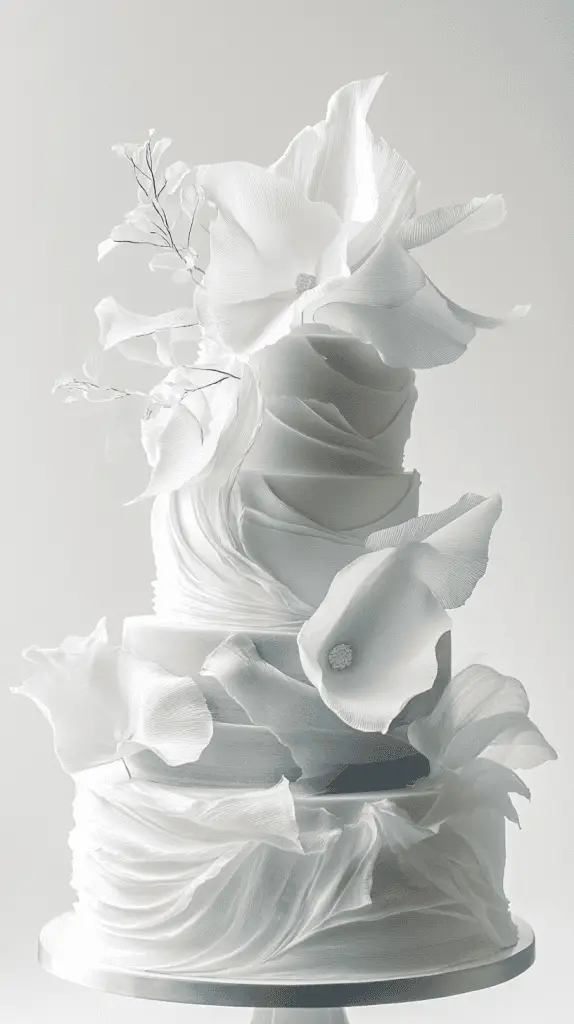
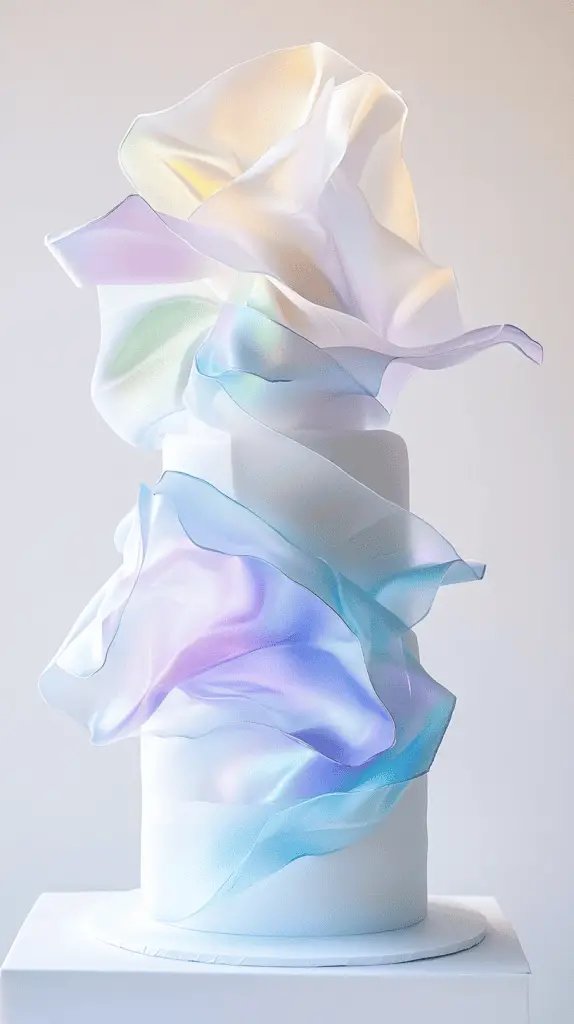
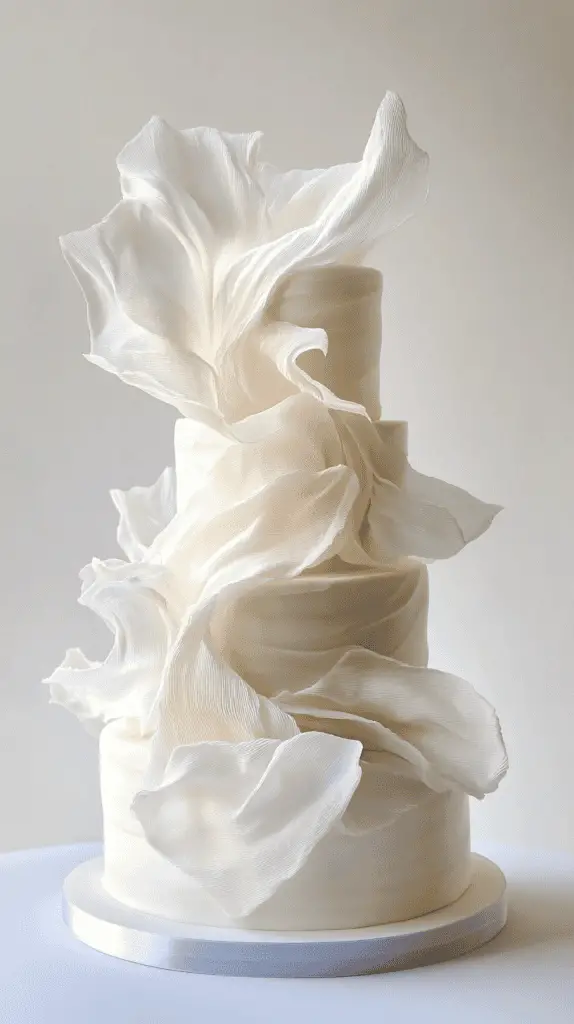
Wafer paper creates stunning opalite-inspired veils and ruffles that mimic the stone’s translucent shimmer. This edible material transforms ordinary wedding cakes into ethereal masterpieces.
Essential Materials:
- Saracino 0.27mm or AD-grade 0.27mm wafer paper
- Scissors
- Pot of water
- Piping gel or royal icing for attachment
The key to achieving opalite effects lies in proper wafer paper conditioning. Bakers lightly mist the paper with water to create pliable, fabric-like textures that catch light beautifully.
Creating Opalite Veils
Cut wafer paper into flowing, irregular shapes that resemble natural stone formations. The material’s natural translucency mimics opalite’s mystical appearance without additional colouring.
Layer multiple pieces at varying heights to create depth and dimension. Each layer should overlap slightly to enhance the stone’s characteristic play of light.
Architectural Ruffles
Modern architectural ruffles work exceptionally well for opalite themes. Steam or lightly dampen the wafer paper edges to create organic, flowing curves.
Position ruffles vertically along cake sides to simulate opalite’s natural striations. The material’s flexibility allows for dramatic cascading effects.
Storage Considerations
| Storage Method | Duration | Humidity Requirements |
| Refrigerator | 2-3 days | Low humidity |
| Cardboard box | 1-2 days | Room temperature |
| Airtight container | 24 hours | Controlled environment |
Wafer paper opalite decorations maintain their shape best in dry conditions. Avoid exposure to moisture once positioned on the cake.
8. Gilded Opalite with Gold-Leaf Inlay
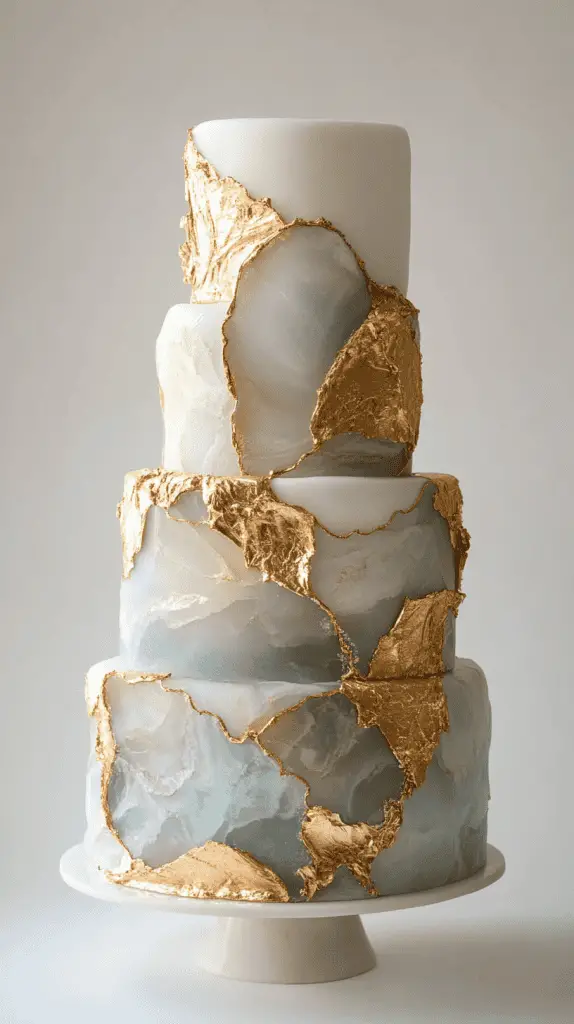
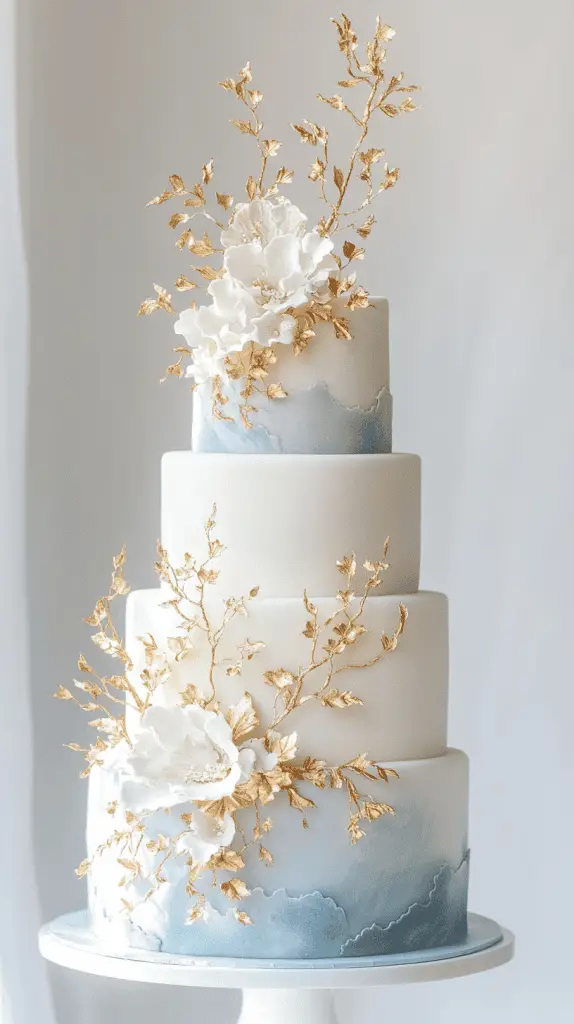
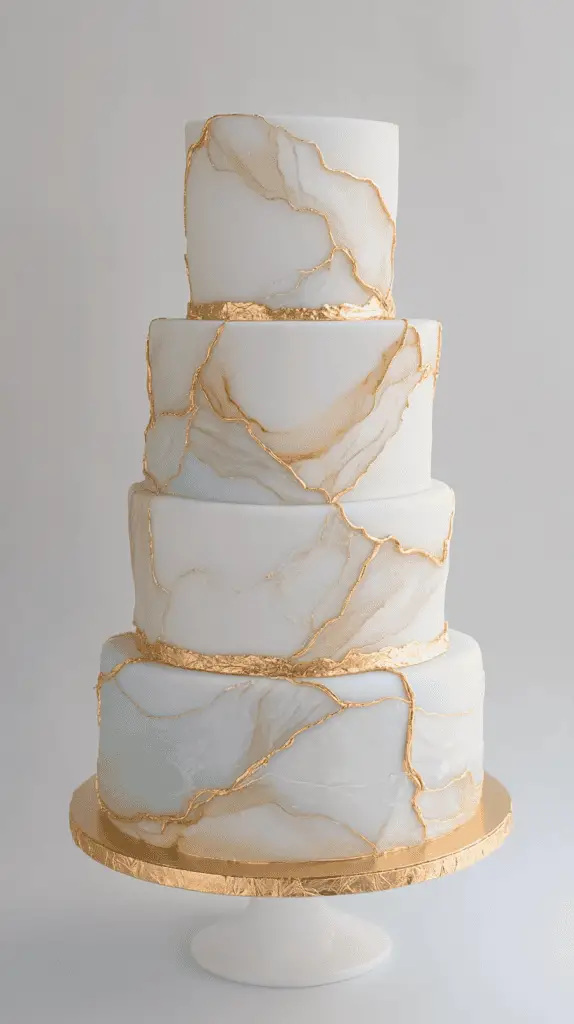
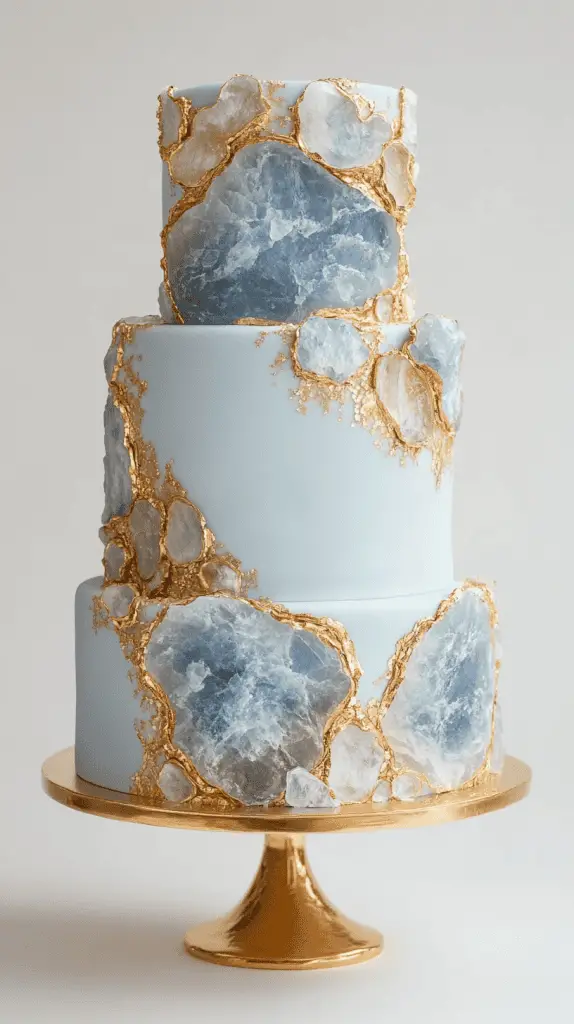
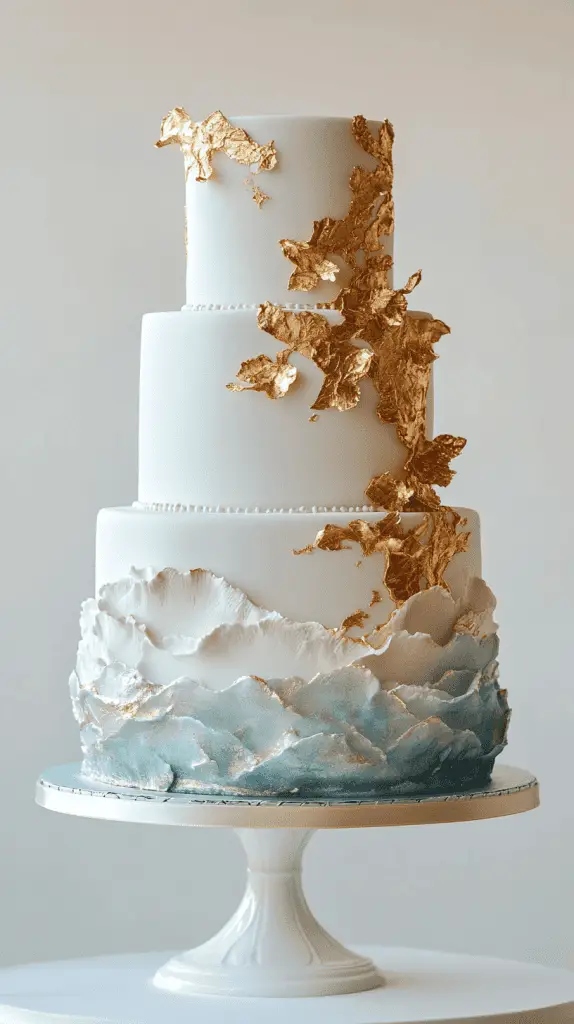
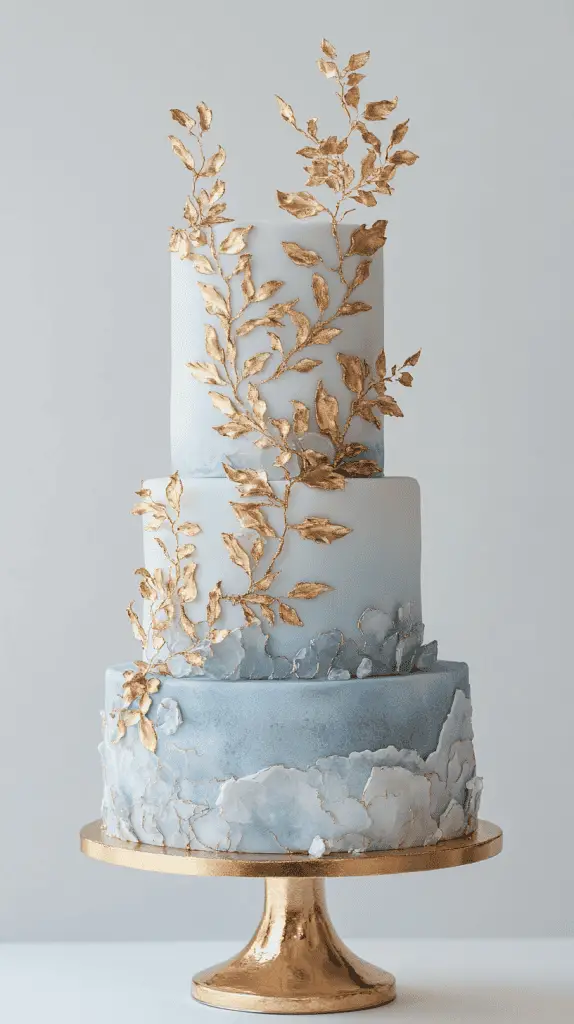
Gold leaf application transforms opalite wedding cakes into luxurious masterpieces. The metallic finish complements opalite’s natural iridescence whilst creating dramatic visual impact.
Essential Materials
- Edible gold leaf sheets
- Soft brush for application
- Tweezers for precision work
- Adhesive (honey or corn syrup)
Bakers typically apply gold leaf to fondant-covered tiers for optimal adhesion. The process requires approximately 20 minutes per 8-inch tier. Temperature control remains critical during application.
Application Techniques
| Method | Coverage | Difficulty |
| Full tier coating | Complete | Advanced |
| Accent strips | Partial | Intermediate |
| Delicate details | Minimal | Beginner |
Strategic Placement Options
- Tier borders and edges
- Opalite gemstone outlines
- Decorative flourishes
- Monogram accents
The gold leaf creates stunning contrast against opalite’s milky translucence. Bakers often combine techniques, using full coverage on bottom tiers and delicate accents higher up.
Storage Considerations Gold-leafed cakes cannot be refrigerated or frozen. Condensation damages the metallic finish and underlying icing. Room temperature storage maintains the pristine appearance.
Professional cake decorators recommend completing gold leaf work after final assembly. This approach prevents damage during stacking. The metallic elements catch light beautifully, enhancing the opalite theme’s ethereal qualities.
Each tier should be handled with gloves and spatulas to preserve the delicate gold surface during transport and display.
9. Celestial Opalite: Moons, Auras & Constellations
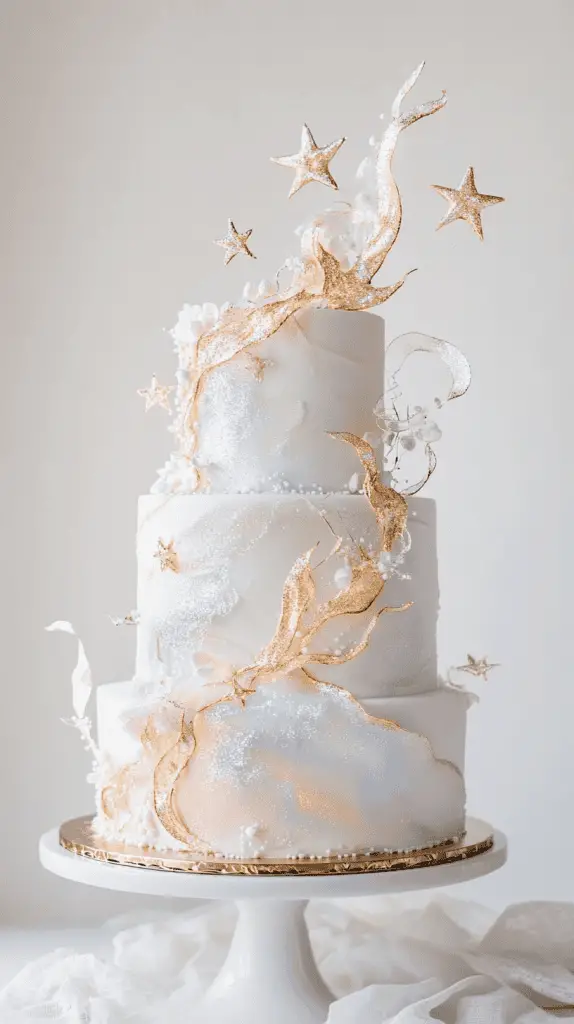
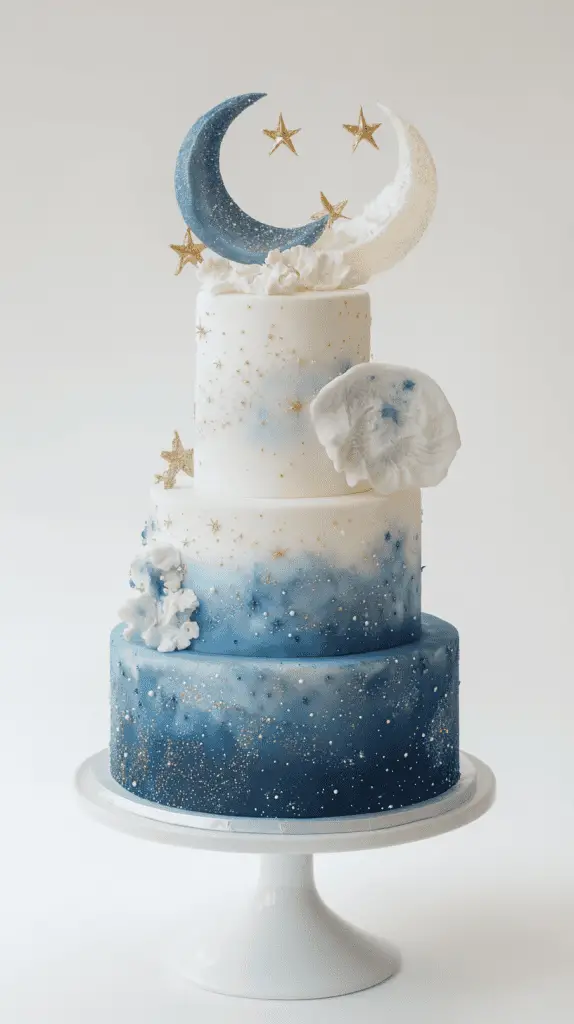
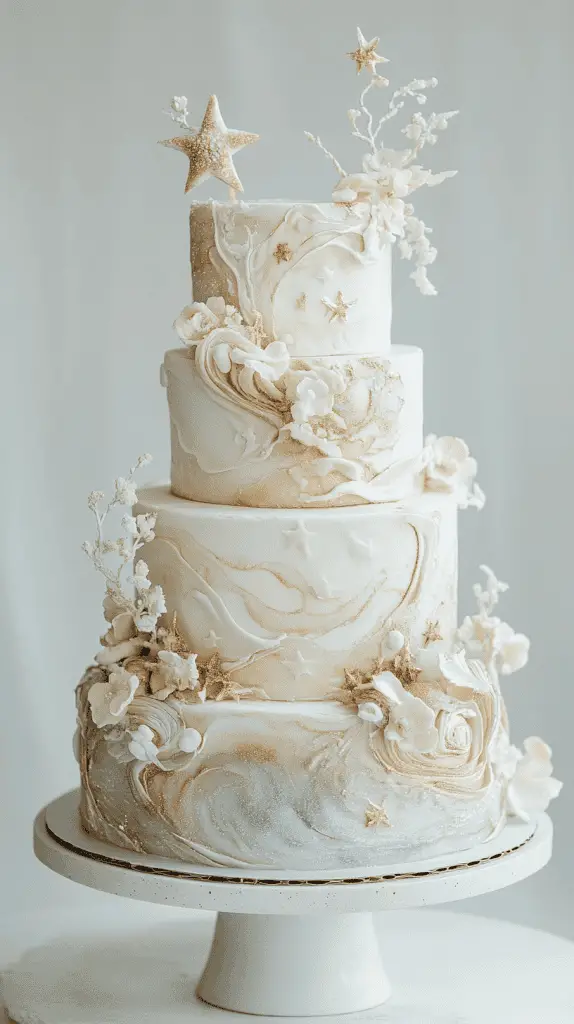
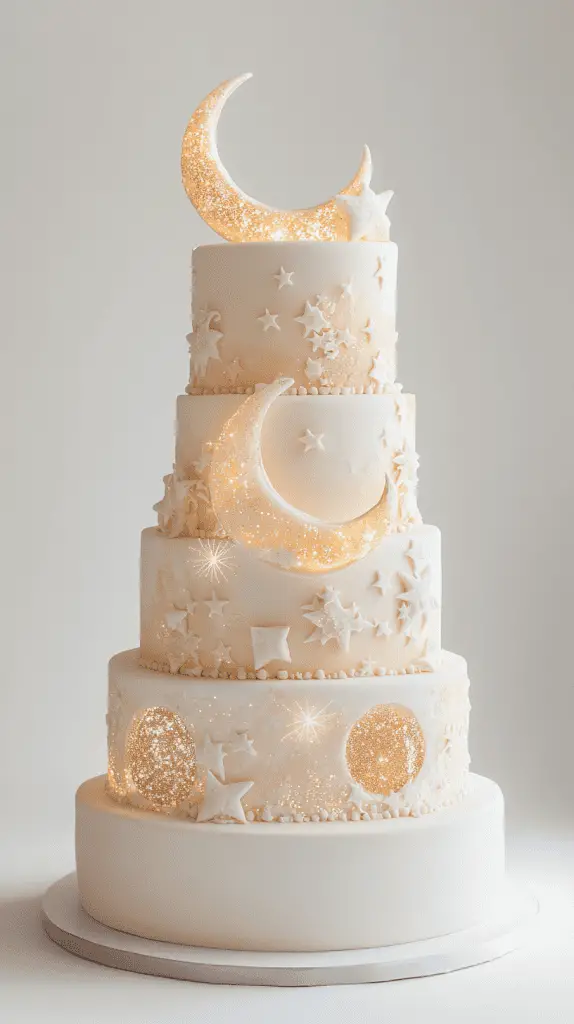
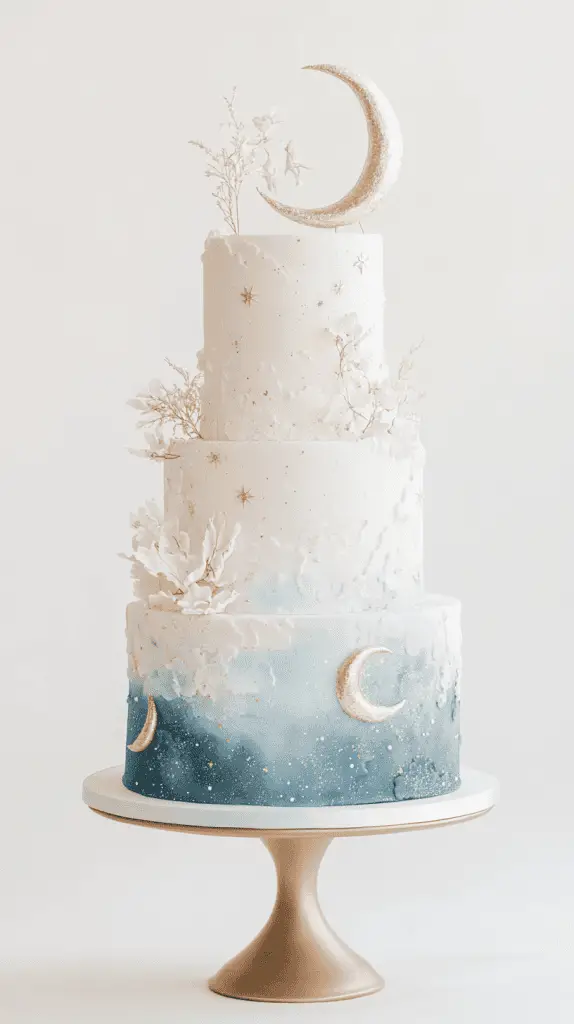
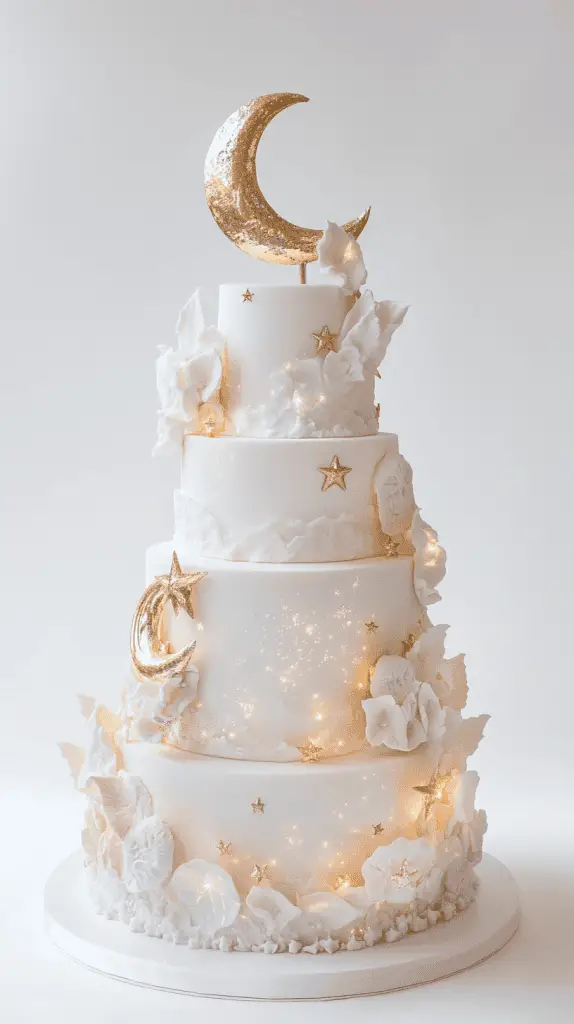
Celestial-themed opalite wedding cakes capture the mystical beauty of the night sky. These designs incorporate moons, stars, and constellations to create ethereal masterpieces.
Opalite’s natural iridescent properties make it perfect for celestial designs. The stone’s milky translucence mimics moonlight and starry skies beautifully.
Popular celestial elements include:
- Crescent moon toppers and decorations
- Star-shaped opalite accents
- Constellation patterns across cake tiers
- Galaxy-inspired colour gradients
Moon phase decorations work particularly well with opalite’s lunar appearance. Bakers often create cascading crescent moons down cake sides using carved opalite pieces.
Constellation patterns can be achieved by embedding small opalite chips throughout fondant or buttercream. These create stunning starry effects when light hits the stone.
| Design Element | Effect | Best Placement |
| Crescent moons | Mystical elegance | Cake topper |
| Star clusters | Sparkling detail | Tier borders |
| Galaxy swirls | Cosmic movement | Background |
The stone’s natural aura-like glow enhances celestial themes without overwhelming other decorative elements. Many couples choose opalite specifically for its connection to lunar energy and cosmic symbolism.
Lighting plays a crucial role in celestial opalite designs. LED lights placed beneath transparent opalite elements create magical glowing effects that enhance the otherworldly appearance.
These cakes work exceptionally well for evening receptions where ambient lighting can showcase the opalite’s natural luminescence.
10. Coastal Opalite: Pearls, Shells & Seafoam Textures
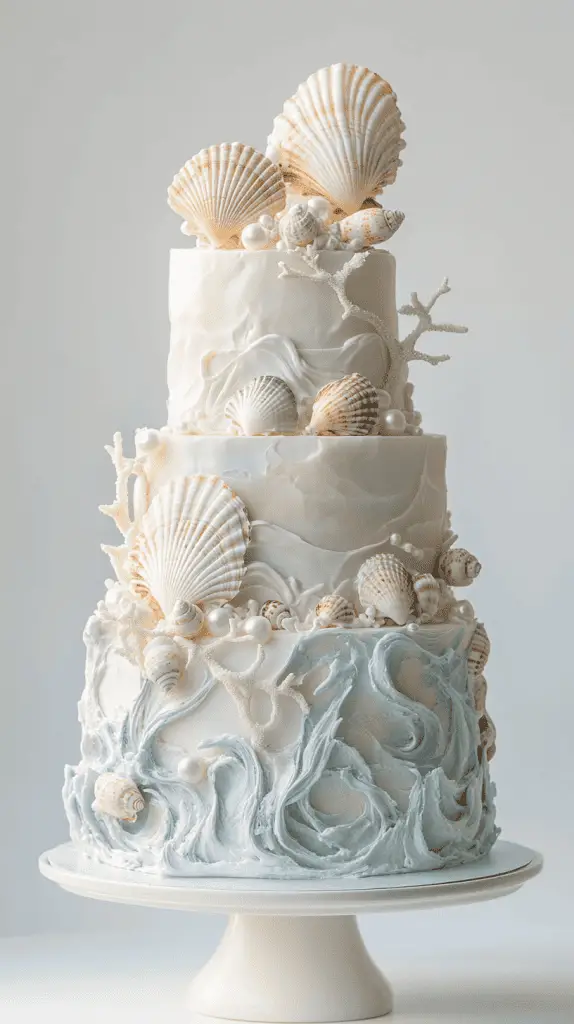
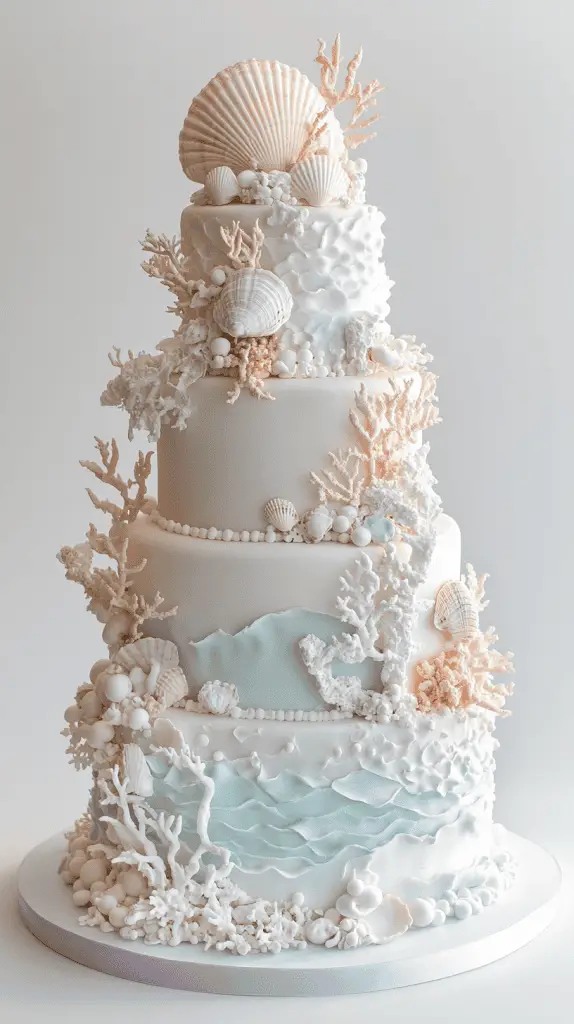
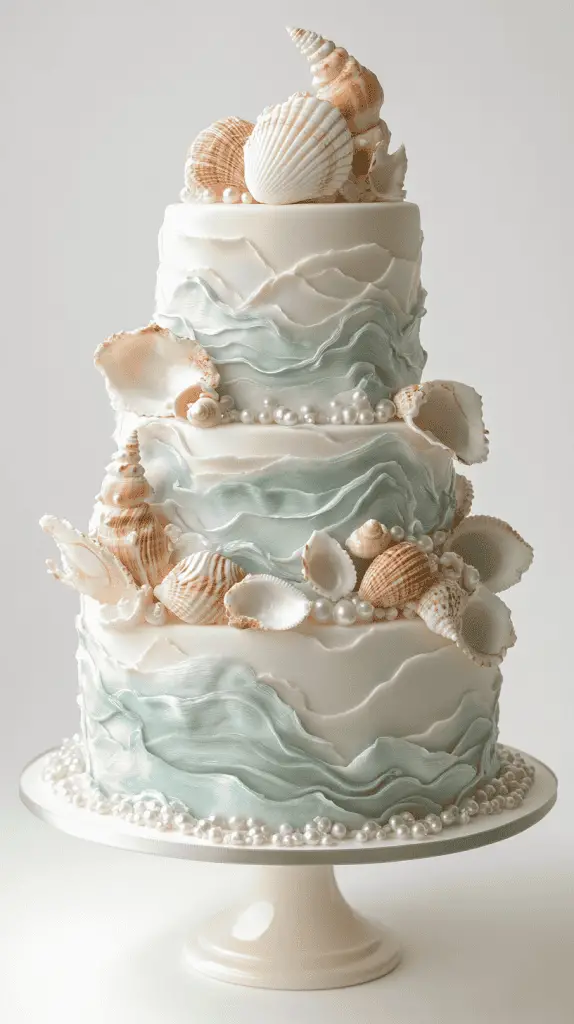
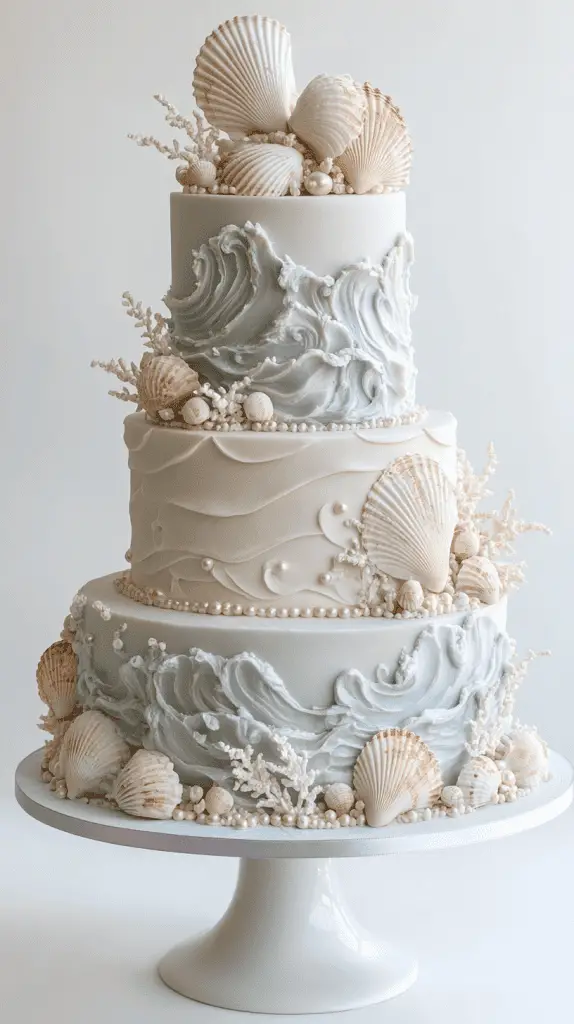
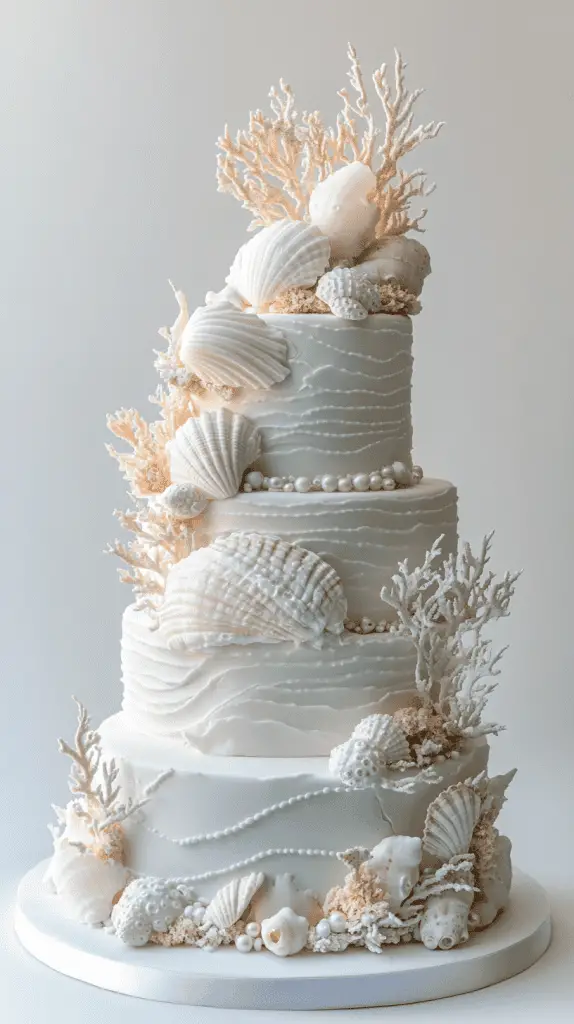
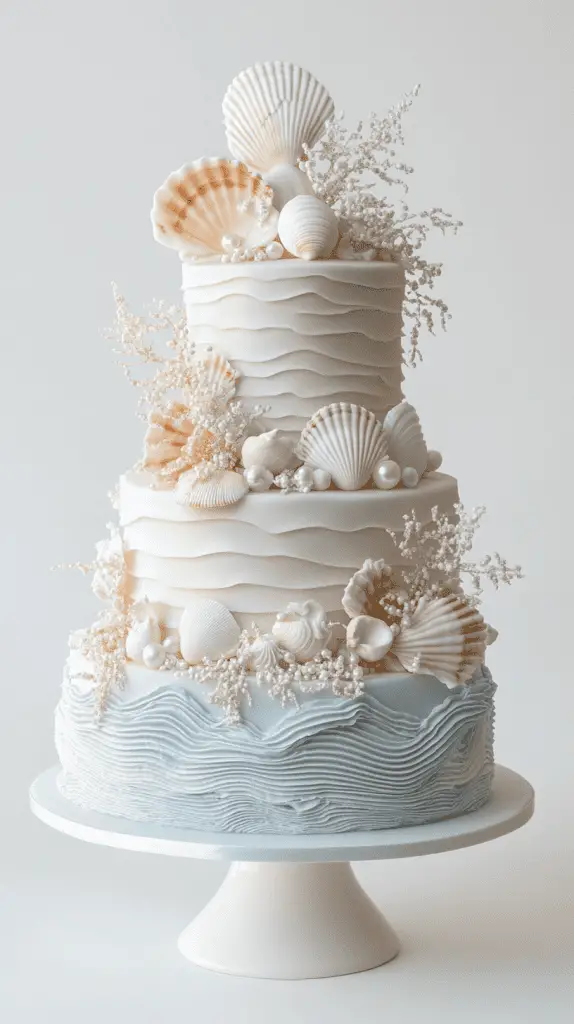
Coastal-inspired opalite wedding cakes capture the ethereal beauty of seaside elements. The stone’s natural translucent quality mirrors ocean depths and pearl luminescence.
Pearl Accents enhance opalite’s inherent shimmer. Sugar pearls cascade down cake tiers like scattered treasures from the sea. Bakers create varying pearl sizes to add visual depth.
| Pearl Technique | Effect |
| Oversized sugar pearls | Bold statement pieces |
| Tiny pearl trails | Delicate jewellery-like detailing |
| Pearl clusters | Organic groupings |
Seashell Decorations complement opalite’s oceanic theme beautifully. Hand-moulded fondant shells receive mother-of-pearl painting to match the stone’s iridescent properties.
Popular shell varieties include:
- Delicate scallop shells
- Spiral conch designs
- Miniature starfish accents
- Coral branch formations
Seafoam Textures replicate ocean movement through buttercream artistry. Piping techniques create soft, airy swirls that dance around cake tiers like gentle tides.
The technique involves layered buttercream application with palette knives. Decorators build texture gradually, creating natural wave patterns that complement opalite’s flowing appearance.
Colour palettes remain neutral – whites, champagne, and soft blues mirror both opalite’s translucence and coastal environments. These hues prevent overwhelming the stone’s subtle beauty.
Metallic touches in silver or rose gold enhance the overall coastal theme. Light applications of edible metallic paint on shells and pearls create sophisticated shimmer without competing with opalite’s natural luminescence.
Frequently Asked Questions
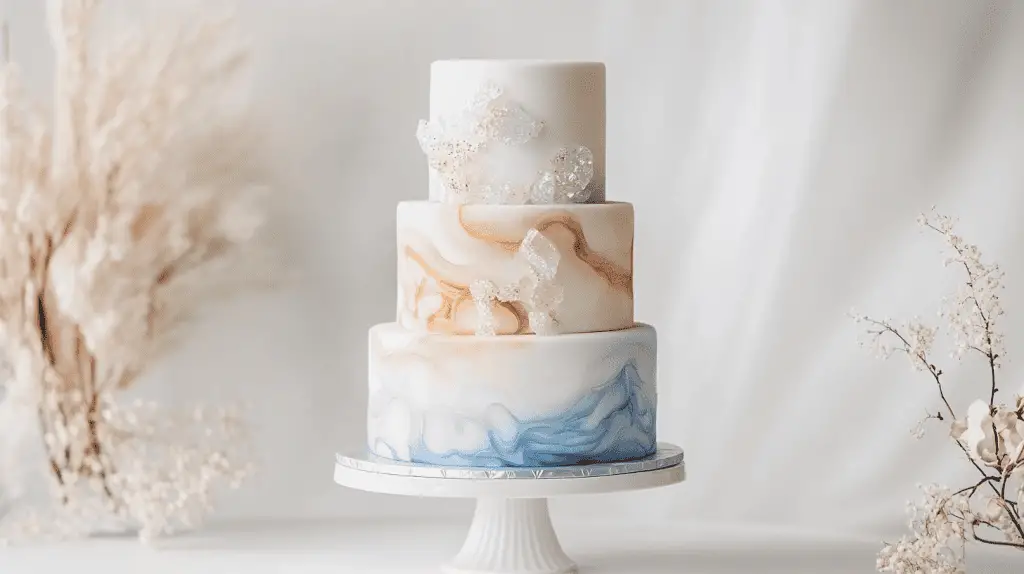
Opalite wedding cakes present unique considerations from seasonal trends to structural challenges. These questions address the most common concerns regarding colour pairings, frosting techniques, and proper care of opalite elements.
1. What are the key trends in opalite wedding cake designs for this season?
Modern opalite wedding cakes favour minimalist designs with strategic placement of stones. Cascading arrangements down tiered cakes create elegant flow patterns. Single statement pieces positioned at tier transitions provide sophisticated focal points.
Geometric patterns incorporating opalite chips have gained popularity. Bakers create mosaic-style borders using small opalite fragments. These designs work particularly well on square or hexagonal cake shapes.
Mixed media approaches combine opalite with metallic accents. Rose gold and champagne elements complement opalite’s natural shimmer. Couples increasingly choose asymmetrical placements over traditional symmetrical designs.
2. How can one incorporate opalite into a wedding cake while ensuring structural integrity?
Opalite stones require proper support systems to prevent cake damage. Heavy pieces need dowel reinforcement beneath their placement points. Bakers should position larger stones over cake board layers rather than unsupported areas.
Food-safe sealant protects both the stone and cake from contamination. Edible adhesive alternatives include royal icing or chocolate ganache for lighter pieces. Wire supports can secure pendant arrangements when properly food-wrapped.
Weight distribution becomes critical with multiple opalite elements. Designers calculate total weight before finalising placement patterns. Bottom-heavy arrangements provide better stability than top-loaded designs.
3. What frosting techniques complement opalite accents on wedding cakes?
Smooth buttercream finishes create ideal backdrops for opalite’s natural texture. Semi-naked cake styles allow the stone’s translucent qualities to shine. Ganache provides rich contrast against opalite’s pale tones.
Textured buttercream techniques like combing or rosette patterns add visual interest. These methods create depth without competing with opalite’s ethereal appearance. Watercolour buttercream effects echo opalite’s shifting colours.
Fondant offers the cleanest base for opalite mounting. The smooth surface prevents visual distraction from the stone’s beauty. Fondant also supports heavier opalite pieces more effectively than buttercream alone.
4. Can you suggest some colour schemes that pair well with opalite decorations on cakes?
Dusty rose and blush pink create romantic combinations with opalite’s natural warmth. These soft tones enhance opalite’s peachy undertones. Cream and ivory provide neutral foundations that don’t compete with the stone’s natural beauty.
Sage green and eucalyptus tones offer fresh, botanical pairings. These colours complement opalite’s blue flash properties. Deep navy creates dramatic contrast whilst maintaining elegance.
Champagne and gold metallics amplify opalite’s inherent shimmer. These warm metals reflect light similarly to the stone itself. Lavender and periwinkle blue echo opalite’s cooler colour shifts.
5. What are the best cake flavours to pair with opalite decor for a wedding?
Vanilla bean cake provides a classic foundation that doesn’t overshadow opalite’s subtle beauty. Lemon or citrus flavours complement the stone’s light, ethereal qualities. These bright tastes mirror opalite’s uplifting energy associations.
Delicate floral flavours like elderflower or rose align with opalite’s romantic symbolism. Earl Grey or lavender cakes create sophisticated pairings. These subtle flavours maintain focus on the visual elements.
White chocolate or champagne cake flavours echo opalite’s pale colouring. Coconut provides tropical sweetness without overwhelming intensity. Light fruit flavours like pear or white peach offer gentle complexity.
6. How should opalite be cared for in relation to wedding cake designs to maintain its lustre?
Opalite requires gentle cleaning with soft, dry cloths before cake application. Harsh chemicals or soaking can damage the stone’s surface finish. Brief rinsing with cool water removes any dust or residue.
Storage in padded containers prevents scratching during transport. Individual wrapping protects multiple pieces from contact damage. Room temperature storage prevents thermal shock that might cause cracking.
Food contact requires thorough sanitisation with food-safe cleaning solutions. Proper drying prevents water spots that diminish lustre. Post-wedding cleaning restores stones for future use or keepsake purposes.

